D S l O WN
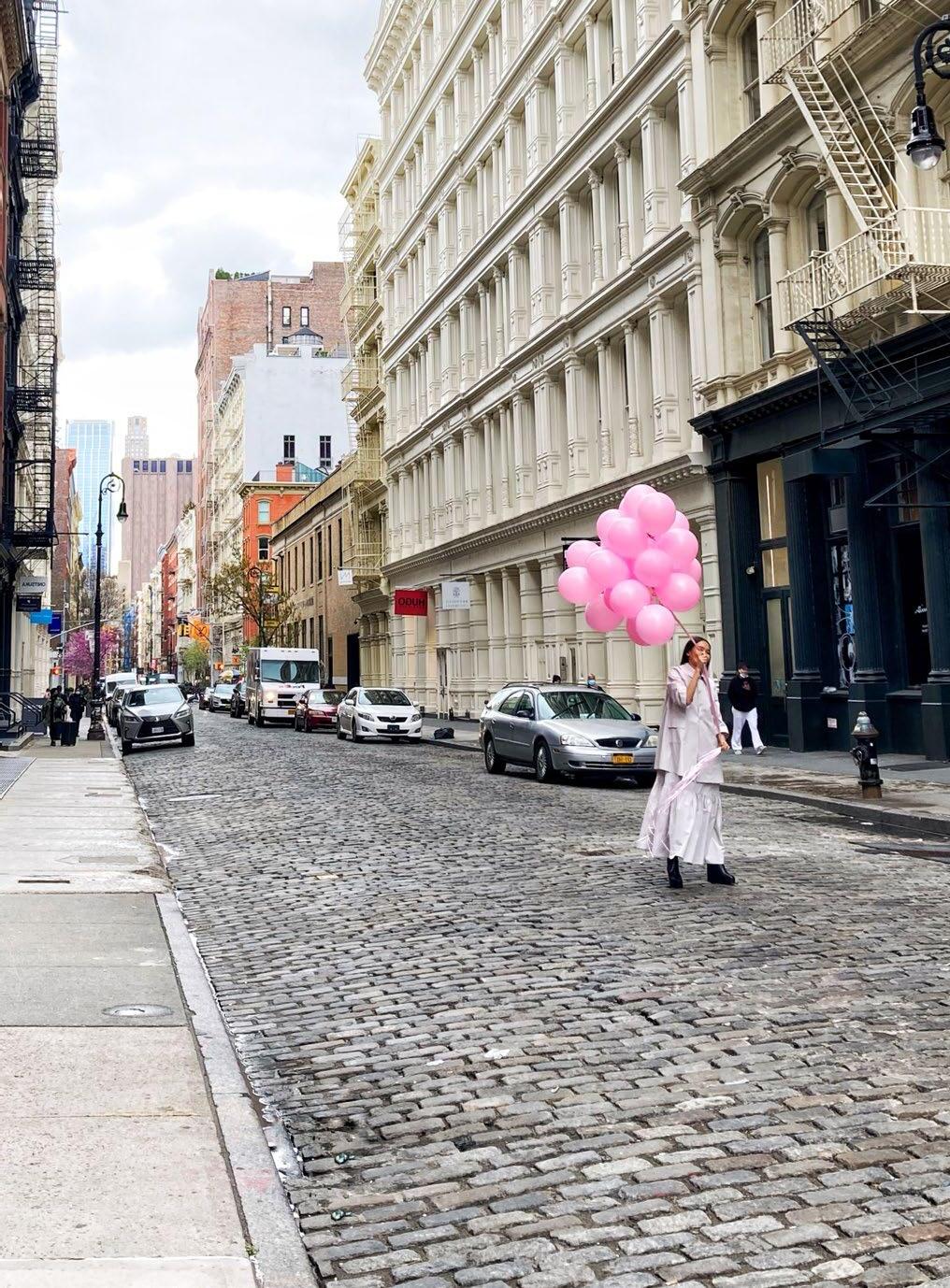
THE
INSPIRATION FROM AROUND THE WORLD FOR AN AESTHETIC AND MEANINGFUL LIFESTYLE ISSUE N o 02 | 2022 thestylemate.com
Stylemate
Essentials
Page 3 Slow. New. York.
Pages 4–7
LIFE:
Interview with Rocco Bova: Go with the flow
Pages 8–9
Slow Food: The man at the cutting edge
Pages 10–13
Franzobel
Page 14
STYLE: Solo
Pages 15–19
Eclectic equilibrium
Pages 20–23
Kanshitsu
Page 24
Helder Suffenplan: The scent of the time
Page 25
Green transition
Pages 26–27
Lifestylehotels™
Hotel Lemongarden & Hotel Das Tyrol Page
The
Gradonna ****S Mountain Resort Chalets & Hotel Page LH 05
Bergland Design- and Wellnesshotel Sölden
Page LH 06
Hotel Stein Page LH 07
Hotel Goldgasse
Page LH 08
Naturresort Puradies
Page LH 09
Geinberg⁵ Privat Spa Villas
Pages LH 10–11
Mia Alpina
Family Retreat Page LH 12
Imprint Page 2
Summer has arrived and the sun is warm. Everything appears to be somewhat slower and we’re allowed to let go, perhaps even embrace the slowness entirely. After a period of being driven by the busy times in between coronavirus variants, when we almost celebrated the exhausting of everything day and night had to offer, there’s now dawdling, inertia and perhaps even a rut to explore. It does us good, and allows us to internalise new things, because conscious slowing down should never be equated to inactivity. For us, it means taking a walk with photographer Susan Kaufman through “her” New York – or maybe it’s more like strolling, wandering and looking around. With Susan, we experience the slow side to the city that never sleeps, because it does actually exist. Places where the heart stops racing and you can breathe more deeply and stimulate your mind. We were also inspired by the conversation with passionate and successful hotel entrepreneur Rocco Bova, who captivated us with his unexpected ideas and his own project My Humble House. A moment to unwind can be found in the Milanese town house belonging to architect Tiziano Vudafieri and fashion manager Catherine Vautrin, where they have created an eclectic equilibrium of design and art in a former glass factory. Finally, keep your eyes peeled – the Lifestylehotels Selection in this issue contains a hot tip for discovering slowness that you won’t want to miss.
Thomas Holzleithner & Hardy Egger EDITORS
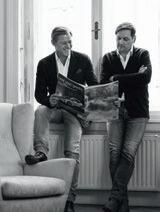
NEUNZEHN-NULL-VIERProject management: Dominik Thamer–Agency NEUNZEHN-NULL-VIER- Writers: Franzobel, Helder Suffenplan, Lisbeth Wild
Translators: Katherine Nussey, Lisbeth Wild Advertising: office@thestylemate.com Printed by: Medienfabrik Graz, 8020 Graz Published
2 THE Stylemate Issue No 02 | 2022 Photo: Heldentheater
IN THIS ISSUE IMPRINT Media owner and publisher: Prime Time Touristik & Marketing GmbH, Schmiedgasse 38/1, 8010 Graz, Austria Editors: Thomas Holzleithner & Hardy Egger Editor-in-chief: Mag. Nina Prehofer–Agency NEUNZEHN-NULL-VIERManaging editor: DI (FH) Christin Maier-Erlach Layout: VON K Brand Design Cover: Susan Kaufman Concept and Editorial Office: Georg Hoffelner, Julia Rinesch, Hannah Stefitz–Agency
in: Graz Publication : 3x yearly
Lemongarden Page LH 01
Selection: Hotel
Page LH 02
Directory Lifestylehotels™
LH 03
LH 04
Secret Sölden Page
Take it slow.
Be sure to subscribe to THE Stylemate so you'll never miss an issue! thestylemate.com speed UP
to
VINTAGE LOVE
We’re taking it back to 2008, when the spring and summer were characterised by grey and cloudy skies, leading to a lack of light and warmth. Not ideal conditions for valuable grapes. In September, however, everything changed and the sun and wind totally turned the situation around, allowing the grapes to ripen with a never-seen-before balance. The result was a bouquet based on raspberries and wild strawberries. Prolonged powdery notes of iris and violet blend instantly with the fruity aromas. After breathing it in the green nuances come in, reminiscent of privet, angelica and camphor –pure elegance in a glass.
domperignon.com, Dom Pérignon Rosé Vintage 2008, approx. € 305
Essentials

MOON BOOTS
There’ll be nothing stopping you from dancing under the midnight sky in the new Moonlight Ankle Boots from Louis Vuitton. Designed as part of the spring/ summer 2022 women’s collection by Nicolas Ghesquière and inspired by The Grand Bal of Time, the Moonlight boots embody the meeting point between the avant-garde and the unique heritage of a brand. The design process involved experimenting with a combination of materials, from gleaming satin to luxurious leather. Patent black, emerald green, royal blue and a graphic polka dot print will go with every bold style and look, and make a statement with their modern aesthetic.
louisvuitton.com, approx. € 1,250

AN OLFACTORY JOURNEY
This summer, the iconic Summer Editions by Issey Miyake are taking us on a journey. It’s an invitation for some downtime, to the rhythm of the water, that breaks free of any clichés, combined with the most beautiful memories of the Mediterranean belonging to the three perfumers at Firmenich, Dora Baghriche, Daphné Bugey and Marie Salamagne. Following the cadaver exquis (exquisite corpse) concept, the perfumers continued each other’s work during the creation of these perfumes, giving rise to entirely unique scents in which their emotions meld together. The result is two olfactory journeys fed by the memories of their creators.
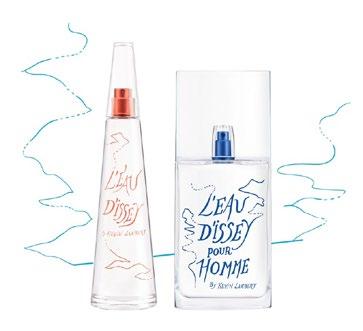
isseymiyakeparfums.com, L’Eau d’Issey Au Fil de L’Eau EDT 100 ml, approx. € 62
IN THIS EDITION
#TIDE
The new AIKON #tide by Maurice Lacroix shows how upcycled ocean-bound plastic can be used to make an exceptionally stylish and precise watch collection that is also the most dazzling and unconventional range of watches to be released by Lacroix. The AIKON #tide is the product of the collaboration between Maurice Lacroix and #tide, a Swiss company that fishes out discarded plastic from the oceans. Thanks to an advanced technique, this ocean plastic can be turned into plastic granules that are then used to make the collection in eight different colour combinations. It’s a Swiss made upcycled masterpiece.
mauricelacroix.com, Maurice Lacroix AIKON #tide, approx. € 850
LOOK WHO CAME TO DINNER
Looking for a surprise guest for your dinner party?

CALM YOUR VAGINA
“Eye cream for your vagina” – that’s how the producers of the Happy Clam Everyday Oil describe it. With the help of CBD, the vagina is kept happy, healthy and moisturised. The Quim brand firmly believes that vaginal health is a precursor to the pursuit of pleasure. For that reason, their products have been developed using a sustainable and self-care approach, infused with CBD in order to improve everyday vaginal health and therefore also sexual pleasure. For humans with vaginas and humans without vaginas who love vaginas.
itsquim.com, Happy ClamTM Everyday CBD Oil, approx. € 86
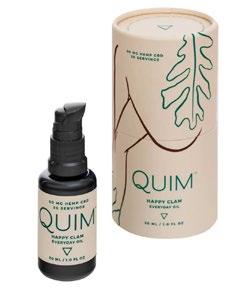
Let ODREY shine from the ceiling. After all, the elegant luminaire is fantastic with its eight different shade shapes and variable inner cover. Don’t be surprised if your guests look up more often. It’s hard to resist the temptation when the elegant ODREY winks from its black or gold shade. By the way, if you really want something unique, choose a mounting in a contrasting colour. You can choose between black, white or gold.
weverducre.com/en/products/collections/ odrey-collection
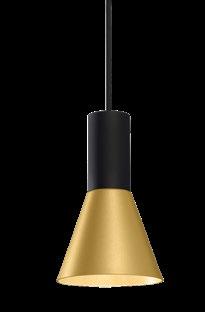
3 THE Stylemate Issue No 02 | 2022 Photos:
Issey
TM Wever & Ducré
DomPérignon,
Miyake, Louis Vuitton, Maurice Lacroix, Quim
slow
Susan Kaufman is taking us on a stroll through her very own New York City. The quiet places. West Village. The quaint small town in the middle of Manhattan. Bagels and old brownstones. In her book ‘Walk With Me: New York’ she shows us how to slow down in a city that never sleeps.
new york
Even with the pandemic finally being somewhat "over", the world is still heading from one chaos into the next. While Susan can’t help worrying about the state of the world, she’s also focusing on all the good things that are happening right now–appreciating all the small and big things in life: beautiful spring weather on the horizon, spending more time with the family and friends, and the launch of her book: Walk With Me: New York. It depicts a side of New York that only few people are aware of.
She started shooting photos of NYC whenever she was out and about and saw something special that caught her eye. On these walks Susan discovered many beautiful homes, streets and shopfronts that she had never taken the time to notice before. Once she started posting these photos on Instagram she began hearing from many of her followers that they wished they could walk with her and see the city through her eyes. It’s thanks to them that the idea of her book was born. Walk With Me: New York, is her very personal portrait of the city that she loves. Her favourite neighbourhood to stroll around (and shoot) is the West Village. It’s like a quaint small town in the middle of Manhattan filled with beautiful old brownstones, lots of charming cafés, interesting shops and so much history!
“For a quick coffee I love Jack’s Stir Brew on W. 10th, and for a longer sit down/hang out with friends I always head to Italian café Bar Pisellino on Grove Street. I’m lucky to live around the corner from one of the best bagel shops in the city: Bagel Bob’s on University Place in Greenwich Village.”
Susan knows the city like the back of her hand. If she had to describe New York City to someone who’s never visited before, she would say that it’s an exciting and incredibly diverse city, with a wonderful mix of different cultures, architecture, art and commerce – it's like nowhere else in the world! It’s about a stunning NYC skyline with modern soaring skyscrapers and iconic landmarks like the Empire State Building and the Freedom Tower, but it’s also about the pastoral beauty of Central Park and unexpectedly charming neighbourhoods like historic Gramercy Park. But it’s really the energy of the people that makes it so unique. New Yorkers will never really slow down, but people are starting to reevaluate their work-life balance and what’s important to them. The pandemic hit NYC so hard in the early days, and it was so eerily quiet, that she thinks New Yorkers are happy to see the energy coming back to their city. Vibrant is always a word she will associate with NYC. True New Yorkers will always walk fast, talk fast and hustle.
But even New Yorkers have realised how important relationships are and spending quality time doing what they love. Quality time key word to slowing down, and for Susan slowness means being aware of the moment she’s in – not always worrying about the future or the next thing she has to do but appreciating what she has here and now. “As cliché as it sounds, it’s making sure to feel grateful on a daily basis. It’s also about taking time to enjoy simple things that bring you joy.” The sheer variety of things to do in NYC can be fun and exciting but also overwhelming, not to mention noisy and frenetic–it’s “the city that never sleeps” for a reason. So can she ever really slow down in NYC? Yes! There are many places to find pockets of calm.
There are so many little parks, the New York Public Library (one of her favourite quiet spaces) and art galleries, for example. And she can always choose to balance the need to go out all the time with quiet evenings at home with family or friends; doing something that brings her joy. For Susan joy means reading a good book, and putting away her phone, having a long conversation with a friend with no distractions, and of course, walking – a lot! Walking really is therapy for her –especially when she’s just exploring with no destination in mind.
BOOK RECOMMENDATION:
Walk With Me: New York by Susan Kaufman, published by Abrams Image, 2022
SUSAN KAUFMAN was the founding editor in chief of Time Inc.’s People StyleWatch magazine. She was named “Editor of the Year” in Ad Age’s “A-List” issue, and under her leadership, People StyleWatch landed the highly coveted number one position as “Magazine of the Year,” also in the “A-List” issue. Her previous roles also include fashion editor at Glamour, fashion director at Mademoiselle and style director at People. She is now a photographer and Instagrammer in her postpublishing career. Kaufman splits her time between her Greenwich Village apartment and her home in the Hamptons, which she shares with her husband and black Lab, Lucky.

4 THE Stylemate Issue No 02 | 2022 LIFE
Author: Hannah Stefitz
Photo: Michael Waring
»

5 THE Stylemate Issue No 02 | 2022
Photo: Susan Kaufman

6 THE Stylemate Issue No 02 | 2022 Photo:
Susan Kaufman
SUSAN’S
4 tips to slow down

• Say no to things you really don’t want to do–it’s OK to be selfish with your personal time. I’ve been doing that more, and I find that my life is much less stressful. Go for an early morning walk. It’s my favourite time to stroll –the city is less crowded and much calmer–especially in neighbourhoods like SoHo and Greenwich Village, but even in midtown too.
• Savour the moment. For me that means sitting at a café by myself with a good cup of coffee and a croissant. It’s when I like to do my social media while enjoying what I’m eating and drinking.
• This might sound harsh, but edit your friends. I’ve realised who I enjoy spending time with and who I don’t, and I’d rather spend more time with fewer friends: the ones who make me feel good, and whose company I truly enjoy.
7 THE Stylemate Issue No 02 | 2022 LIFE
Photo: Susan Kaufman
YOUR INTERVIEW GO WITH
Interview: Nina Prehofer and Hannah Stefitz
Flow
What’s on your mind these days?
I realised that I should stop focusing on small things but rather on important things. The most important thing that helped me move forward was not focusing on the things I couldn’t change. During the pandemic a lot of people became worried about and preoccupied with problems that were beyond their control. I started listening to webinars in my free time. A lot of webinars. However, it was one key fact that saved my job and the jobs of my team–nearly 250 people. Right now I am working on a personal project that was my wish for my 50th birthday–My Humble House. I wanted to create something remarkable that can make a change in the industry.
What was the most important thing you learned during these difficult times?
To never give up and to stay positive. Instead of being negative, I tried to find solutions and help the company I work for and to help others as much as possible. Sometimes just by listening to them as well. I’ve met some incredible people during my lifetime because of this and in this sense of helping others I’ve also helped myself. It’s your responsibility to help yourself. If I can do it, you can do it too.
What is it that hoteliers need to do to help themselves? What advice would you give them?
They’ve been very fortunate during the pandemic in Europe because they have government assistance – reduced tax rates, loans and so on. In Mexico, the government did not provide much support to the private sector, instead it deciding to reopen business as soon as possible so life could return to normal. To my fellow colleagues I recommend staying focused and involving team members in order to find a solution that can benefit everyone. Many employees have great ideas and often understand their job better than a manager. It is necessary to find every possible way to keep the businesses open. Never give up on your dream.
ROCCO BOVA is originally from Italy but has been a global citizen for over 25 years. He's a hospitality industry enthusiast who has worked in 11 countries since 1995–beginning in Europe, then moving to the Middle East, Asia, Africa and finally Mexico more than five years ago, where he currently resides and works on his project My Humble House.
Do you think that we or the industry need to redefine what success means?
We need to redefine what profit is. We need to scrap what profitability is for a business and consider what profitability can be for everyone in a business. My family was not rich but rich in their hearts, so I grew up with important values. However, in a business you think in terms of profit and loss. Why do people who already have a good lifestyle feel the need to earn more instead of maintaining their lifestyle and sharing the rest with others? In my last job I implemented a 10 % service charge for my staff members and only asked one condition: to ensure the service was always great and beyond guests’ expectations. During the high season staff would make double their salary. This helped the business grow, and the team members earned more. This shows that if you treat your team members well, your profits will increase – the tiniest effort can often show the best results.
What inspired you to pursue a career in the hospitality industry?
My mother advised me to get a job when I was 13 years old. I only lasted three days because I broke a lot of glasses and couldn’t carry a tray properly. The owner paid me for three days and told me to leave and return once I had learned how to hold a tray because I cost him more than he had to pay me. That day, I went home eager to return because I knew I could do it. The following summer, I returned to another location for one month, and the following year, I stayed for two months. Then a guy at work asked me what I wanted to do with my life one summer. And I replied that I wanted to travel around the world. He invited me to London, and I went with a friend with just a one-way ticket. And I never returned. I progressed from there, working for a hotel at a nightclub in Egypt, returning to London, and then starting my first job in Dubai. Then to Singapore, Kuala Lumpur, India, Oman, Mauritius, Dominican Republic and finally I reached Mexico where I am currently.
That sounds very hectic. How did you slow down–personally and professionally? If you don’t go with your own flow, you may do something you are not ready for. Of course, you learn from mistakes, but maturity does not come from mistakes only, it comes from daily learning. Today when I talk, people listen to me because I know what I’m talking about.
Let’s talk about some trends in the hospitality industry. What are we going to face?
I always say that I don’t carry a crystal ball. What I hope is going to change is the way we travel. A lot of people talk about how they have been to 120 countries, but they do not know anything about the country they’re in. One thing we need to realise is that we need to travel in order to learn and discover, not just because we want to check it off our list. Sometimes just by ourselves too. I also don’t understand why we need to build huge hotels with 3,000 rooms. These are a few things I wish to change in
the future. I also hope that people become travellers and not just tourists that take away only pictures as souvenirs. Last but not least, we should change the business model. I hope that the new generations are going to change their mindset around the business model. To not be greedy and keep earning more but to become better and generate a circular economy.
You mentioned solo travelling. In the last few years people have been travelling alone to meet new people. Has the industry adapted to solo travellers?
The market is a lot more specific when it comes to solo travelling. I’ve also noticed a lot more female than male solo travellers. Hotels need to be more aware of the needs of a woman. To create a sense of security and a 24/7 point of contact, provide them with a room that is not too secluded. Hoteliers need to make them feel welcome and secure, and they are doing a good job at that already, but they also need to provide specifically designed experiences.
Another shift in travel styles went from quick trips to purposeful travelling?
Yes, and wellness travel is another trend. Transformational trips. Have you heard about the Modern Elders Academy? It’s a school dedicated to helping you navigate midlife and beyond. Through transformations you find a new view on life. Another change in travelling habits is working from somewhere else. Remote working, so to speak. Some hotels are already turning their facilities into a work environment to accommodate working tourists. We have talked a lot about travelling. So, what trips do you have planned? I’m going back home to Italy to see my family. This time for a bit longer as I haven’t had a real vacation in three years. And then I want to do a trip in Mexico every month to really get to know the country–following my own advice and travelling purposefully.
8 THE Stylemate Issue No 02 | 2022
ROCCO BOVA
ROCCO BOVA HAS TRAVELLED ALL OVER THE WORLD, SEEN MANY PLACES, MET MANY PEOPLE AND LEARNED A LOT DURING HIS TIME IN THE HOSPITALITY INDUSTRY. NOW HE IS SEEING THINGS CLEARLY AND FOCUSING ON IMPORTANT THINGS RATHER THAN SMALL THINGS. HE TALKED TO US ABOUT THE CHANGE IN THE WAY WE TRAVEL, PLACES WITH PURPOSE AND GOING WITH YOUR OWN FLOW. WHICH MEANS SLOW TO HIM.
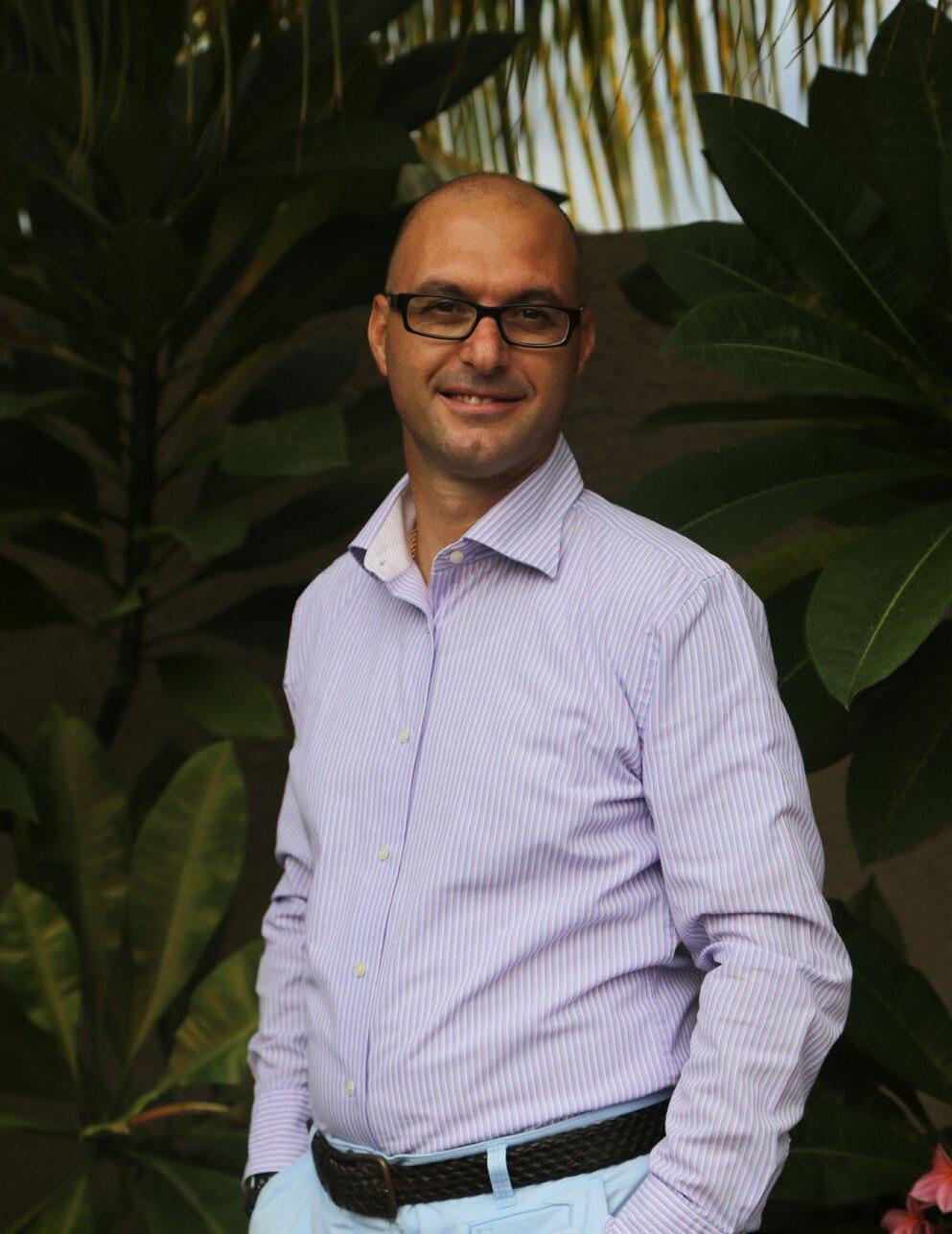
9 THE Stylemate Issue No 02 | 2022
Photo: Nathalie Afonso Inacio

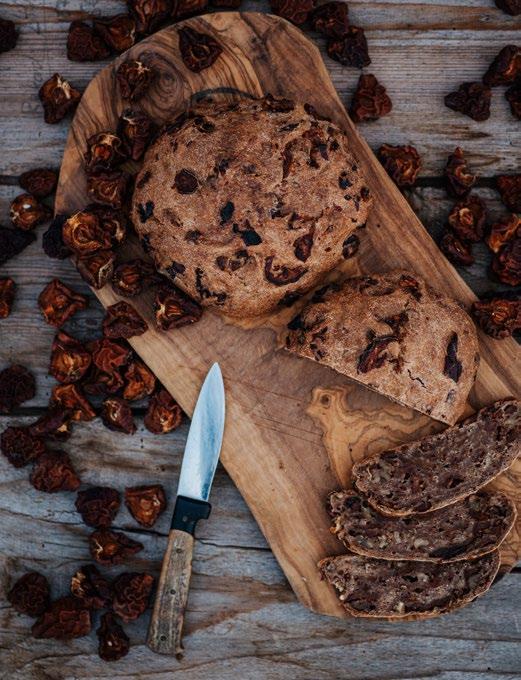
10
ABOUT HERWIG ERTL Many years ago, Herwig Ertl’s culinary festival, his philosophy, his unconventional approach, his calls for greater regionality and his sense for authenticity made him a pioneer and ambassador for the criteria set out by the slow food movement. These days, he is a creative purveyor of fine foods, a lateral thinker, a stubborn advocate and guardian of the fine produce in Kötschach-Mauthen. Photos: Martin Hofmann
HE IS THE VOICE OF HIS REGION AND HAS TRANSFORMED KÖTSCHACH-MAUTHEN INTO A MEETING PLACE AND A DESTINATION FOR GOOD TASTE: SLOW FOOD PIONEER HERWIG ERTL TALKS TO US ABOUT STUBBORNNESS, RICE WITH MEAT AND ACTIVISM ON AN INTERNATIONAL SCALE.
The man
11 THE Stylemate Issue No 02 | 2022 LIFE
Author: Georg Hoffelner
HERWIG ERTL at the cutting edge
You have been an active ambassador for the region for many years, and you’ve achieved a lot during this time. Slow food is, quite literally, on everybody’s lips. This might be a stupid question but let’s get it out the way: why do we suddenly need an English term for something that’s been around for so long? Slow food has been around for as long as there’s been fast food. When the first fast food outlets opened – over 30 years ago –the founder of the slow food movement, Carlo Petrini, said that everyone has the right to good, unpolluted and fairly produced food. Why English? Slow food is a registered trademark, an attitude to life that everyone is invited to adopt in order to preserve what’s valuable, and it’s also the biggest peace demonstration in the world. Everyone who recognises and lives by this philosophy and way of life is making a valuable contribution to nutrition and food culture, and preserving biodiversity. The response to fast food can only be slow food. Fast food is a convenience for many, while slow food is a contribution made by people who question, put ideas into action and want to help create a valuable sense of community for others and for themselves. We need lots of activists – not just those who want to leave the responsibility to others but those who want to actually make a difference.
How blindly persistent do you have to be to embed issues like these over the long term, and more importantly to drive them forwards?
I live in the most delightful corner of Carinthia in Kötschach-Mauthen in the Gailtal Alps, which is in the world’s number one Slow Food Travel region. There is a huge number of invaluable blindly persistent people and pioneers here who have always had to give 110% because they’ve always been an example to others who considered our work to be important, and who now see us as a role model. The fact that St. Daniel was one of the first Slow Food Villages in the world and Mauthen is one of Austria’s 20 designated mountain climber villages hasn’t happened by chance. Only in places where people still have something to say does a region have life. I have always been lucky enough to see and recognise the riches we have on our doorstep. To communicate them to the world under the motto: “If we don’t begrudge other people what they have, we all have enough”. We’re just borrowing things while we’re guests on earth. It’s our duty to guarantee a good future for our children.
Why are conscious consumerism and slow food so important?

Because you don’t just eat your fill, you also deal with cultivation and the heritage of the producers. You question, you enjoy, you don’t leave out anything important. You become creative, you ponder.
You’re grateful that you’re showing an understanding of unpolluted and fairly produced food.
Which product from your region has impressed you recently?
The Lesachtal Bread and Alpe Adria Klozen Pears Presidia (editorial note: Presidia support the production of high-quality food that is under threat of disappearing) were recognised as the top international slow food Presidia in the world. An incredible amount of effort went in to achieving that.
It’s unlikely that just slow food or another label will drive things forwards in a region. What else is required to change the spread of awareness so it reaches a wider audience?
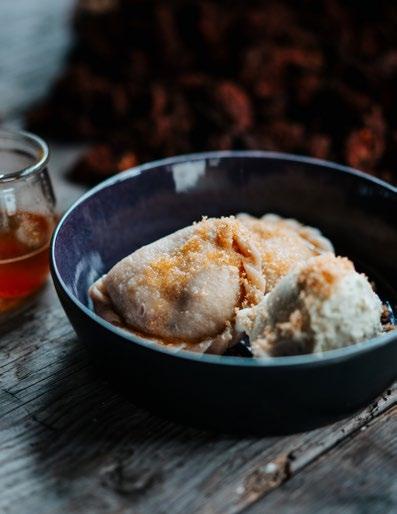
In Carinthia, there’s the Carinthia Association of Slow Food (Verein Slowfood Kärnten), which endeavours to improve the nutrition and food culture in the state. Their work is carried out in schools, regions, communities and at all slow food culinary artisan premises. The special thing about the association is that everyone makes a financial contribution: politics, the Kärnten Werbung advertising company for the state, the regions, the communities, the culinary artisans. We’re amazed that it’s running so well here. However, our goal is to spread word of the philosophy, to make it accessible, to give it a good foundation and to exploit its potential.
A lack of time is frequently cited as an argument for not cooking. How do you manage work and food, or do you perhaps have any tips you can share?
I can’t cook. But I do know what things go well together so we’re always well stocked up on the basics in our kitchen.
I’m grateful that my wife, Marianne Daberer from the daberer organic hotel, cooks for my two boys, Felix and Lorenz, and I every day, despite her workload. And it always tastes amazing.
Many people associate the food they put on their tables every day with childhood memories. What are your earliest foodrelated memories?
At home, Friday was always polenta day, Saturday was rice with meat. Both of these dishes are still among my favourites to this day.
For many people, going out to eat good food has become a luxury. How do you define culinary luxury from your own perspective?
Our only affordable luxury is what our neighbour produces for us and what nature provides for us. We need to appreciate these things and handle them with care. Then we can afford to have them every day herwig-ertl.at
12 THE Stylemate Issue No 02 | 2022 Photos: Martin Hofmann
“IF WE DON’T BEGRUDGE OTHER PEOPLE WHAT THEY HAVE, WE ALL HAVE ENOUGH.”

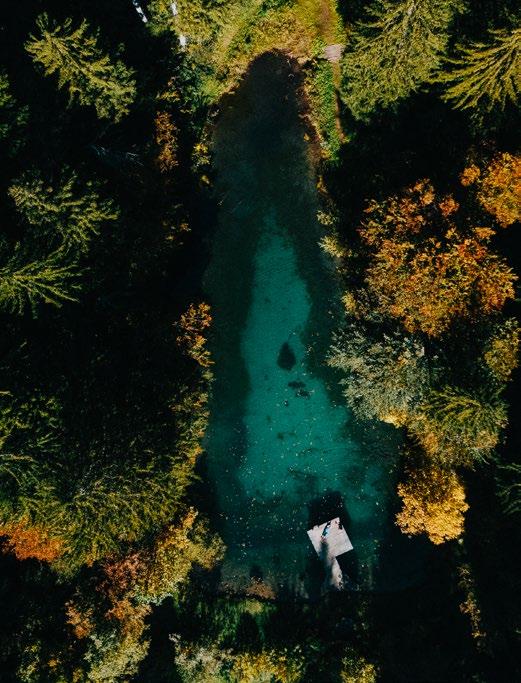
13 THE Stylemate Issue No 02 | 2022
Photos: Martin Hofmann
FRANZOBEL is an Austrian writer. He has published numerous plays, works of prose and poems. His plays have been produced in countries including Mexico, Argentina, Chile, Denmark, France, Poland, Romania, Ukraine, Italy, Russia and the USA.
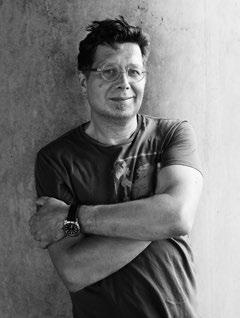
His great historical adventure novel “Das Floß der Medusa” (published by Zsolnay) was awarded the Bayerischer Buchpreis (Bavarian Book Award) 2017 and was on the shortlist for the German Book Prize 2017.
The hamster wheel we call the world is getting faster and crazier. Everyone is racing around, consuming, living. Thank goodness there are also some people slamming the brakes on, standing up for regionality, deliberation and slow food. For many, happiness, wealth and consumerism are their main goals, but for me it’s calmness – not a buzzword that would be suited to political slogans or revolutions. There’s no god or saint of calmness, not even a metaphorical depiction in the world of art. Is calmness the opposite of hysteria? Could you also call it composure? And at what point does it become indifference, anguish or taking a spiritual nap? Yet what’s the use of the calmest calmness when you’re sitting on a plane whose engines have just caught fire, when a dictator has just declared war or you find out that a psychopath has your children in their grasp? That’s when it becomes difficult to remain calm. But even then, calmness is a necessity. People find themselves confronted with an atrocity, their own impermanence. Thank goodness there’s a paradise waiting for us, we might think. Is it perhaps the case that individuals’ spirits are just part of a huge collective consciousness, a global soul that forms the universe? Or are we just dreaming our lives and when we die, we’ll wake up in an all-inclusive hotel with a spa, a buffet and a bar?
Life is by no means just a stringing together of pleasant moments, with irritation caused by disappointments and worries. Thanks to our discoveries in the field of quantum physics, we’re able to see that time and space don’t behave in the way we might expect.
Some neurobiologists believe we’re predetermined by our genes. For others, it’s destiny or fate. Then there’s consumerism, the constant feeling of not earning enough, not being able to afford enough – simply not being enough. The only reasonable option we have to face all of them is stoic calmness.
Calmness evokes faith. Faith in a higher connection, a hidden meaning or the knowledge that a freshly poured beer awaits after work. Without faith, fear about the state of the world eats away at us. We kill and destroy out of fear, put up boundaries, prisons; superpowers hoard unimaginable wealth out of fear of poverty. With a little more calmness, history would be quite a few atrocities better off.
Any time I haven’t been calm – in love, in art, in life – I’ve frozen, which always results in a cramp. But whenever I am vulnerable and have faith, everything works out – at least for the most part. Life is like surfing. Surfers spend the whole day in the sea waiting for the right wave to ride. If they choose the wrong one, they don’t get very far, and if they expect too much from a good wave, they freeze and fall off their boards too soon. It’s only when they stay cool that they get that small amazing ride that then becomes their reason for everything. Perhaps it’s not that different with life: we spend most of our time lying around like crocodiles, only we’re not waiting for prey, we’re waiting for the wave. And when it arrives, only one thing will help: calmness.
Slow down
14 THE Stylemate Issue No 02 | 2022 Photo: Dirk Skiba LIFE
FRANZOBEL
“Life is like surfing. Surfers spend the whole day in the sea waiting for the right wave to ride.”
Selection
Favourite spot
When life gives you lemons, make lemonade – or a hotel: for hotel owner Helena Ramsbacher, it’s a whole garden full of lemon trees that she finds captivating at her heritage hotel Lemongarden on the island of Brač. It’s a unique sanctuary consisting of 300-year-old Dalmatian stone buildings, lovingly renovated down to the smallest detail, an abundantly blossoming garden and two adorable donkeys.
Donkeys? Yes, that’s right! Helena Ramsbacher tells us about them and other things in our interview on page 3.

02 / 22 Lifestylehotels™ lifestylehotels.net
LEMONGARDEN Croatia / Brač / Sutivan
Photo: Christian Husar HOTEL
( + )
Hotel Lemongarden, Brač / Das Tyrol , Vienna (Cover, LH 03)
The Secret Sölden, Sölden (LH 04)
Gradonna Mountain Resort, Kals am Großglockner (LH 05)
Bergland Sölden, Sölden (LH 06)
Hotel Stein, Salzburg (LH 07)
Hotel Goldgasse, Salzburg (LH 08)
Naturresort Puradies, Leogang (LH 09)
Geinberg 5 Private Spa Villas, Geinberg (LH 10–11)
Mia Alpina Zillertal Family Retreat, Fügen (LH 12 )
Lifestylehotels™ Directory
AUSTRIA
BAD GOISERN AM HALLSTÄTTERSEE Hallstatt Hideaway
Mountain | Lesehotel
DAMÜLS Alpenstern Panoramahotel
FISS Alps Lodge
FÜGEN Mia Alpina Zillertal Family Retreat
GASCHURN Montafon Lodge Design Lodgehotel und Spa
GEINBERG Geinberg5 Private Spa Villas
GRAZ Aiola Living
GRAZ Augarten Art Hotel
GRAZ Lendhotel
GROSSARL Hotel Nesslerhof
HALLSTATT Hallstatt Hideaway
KALS AM GROSSGLOCKNER Gradonna Mountain Resort
KALTENBACH Das Kaltenbach
KITZBÜHEL Alpenhotel Kitzbühel am Schwarzsee
LEOGANG Naturresort Puradies
MARIA ALM Hotel Eder
MARIA ALM Hotel SEPP
MAYRHOFEN ElisabethHotel Premium Private Retreat
MELLAU S onne Lifestyle Resort
MÜHLDORF LA PETITE IVY
NAUDERS Arabella Retreat & Spa
OBERGURGL The Crystal VAYA Unique
SAALBACH HINTERGLEMM Alpin Juwel
SALZBURG Hotel Goldgasse
SALZBURG Hotel Stein
SCHLADMING Stadthotel Brunner
SEEFELD dasMAX
SEEFELD/MÖSERN Nidum Casual Luxury Hotel
SERFAUS Alfa Hotel
SÖLDEN Bergland Design and Wellness Hotel Sölden
SÖLDEN T he Secret Sölden
STAINACH-PÜRGG Gästehaus Krenn
UDERNS IM ZILLERTAL Sportresidenz Zillertal
WAGRAIN A lmmonte Präclarum Suites
WAGRAIN Almmonte Sensum Suites
VIENNA Hotel Das Tyrol
VIENNA Hotel Schani Salon
ZELL AM SEE Senses Violett Suites
CROATIA
BRAČ Hotel Lemongarden
ISTRIA Meneghetti Wine Hotel & Winery
STARI GRAD / HVAR Maslina Resort
Stylish retreats for inspiring timeouts.
lifestylehotels.net
GERMANY
GARMISCH-PARTENKIRCHEN Das Graseck
NUREMBERG art&business Hotel
OFFENBURG Hotel Liberty
PIRNA Laurichhof
SANKT ENGLMAR Berghotel Maibrunn
TIMMENDORFER STRAND Sand
TIMMENDORFER STRAND SeeHuus
GREECE
AMALIADA / PELEPONNESE Dexamenes Seaside Hotel
SANTORINI Myst Boutique Hotel
SANTORINI Saint Santorini
SIFNOS Verina Astra
SIFNOS Verina Terra
HUNGARY
BUDAPEST Hotel Collect
INDONESIA
SUMBA Nihi Sumba
ITALY
AMALFI COAST Casa Angelina
APULIA Paragon 700 Boutique Hotel & Spa
CAMAIORE Locanda al Colle
CALABRIA Praia Art Resort
LIMONE SUL GARDA EALA My Lakeside Dream
MATERA Sextantio Le Grotte della Civita
MERANO Steinach Townhouse Meran
MONTEFOLLONICO Follonico
NATZ BEI BRIXEN Seehof Nature Retreat
RIMINI i-Suite
SANTO STEFANO DI SESSANIO Sextantio Albergo Diffuso
SICILY Monaci delle Terre Nere
SICILY ZASH Country Boutique Hotel
VENICE Hotel Heureka
NETHERLANDS
AMSTERDAM Sir Adam
AMSTERDAM Sir Albert
AMSTERDAM TwentySeven Amsterdam
PORTUGAL
ALENTEJO Sublime Comporta Country Retreat & Spa
ALGARVE Vila Valverde
AZORES Santa Bárbara Eco-Beach Resort
AZORES White Exclusive Suites & Villas
CASCAIS The Oitavos
LISBON Torel Palace Lisbon
MADEIRA Quinta da Bela Vista
PORTO Torel Avantgarde
PORTO Torel Palace Porto
PORTO Torel 1884 Suites & Apartments
SPAIN
BALEARICS Es Raco d‘Arta
MALLORCA Convent de la Missio
MALLORCA Fontsanta Hotel Thermal Spa & Wellness
MALLORCA Hotel Can Simoneta
MALLORCA Pleta de Mar
TENERIFE Ecohotel El Agua
SWEDEN
LAPLAND Treehotel
SWITZERLAND
LUCERNE Hotel des Balances
ZERMATT Hotel Matterhorn Focus
The demand for aesthetics and quality is central to LifestylehotelsTM vision of a modern hotel industry and it is inextricably linked to its commitment to sustainability and mindfulness.
Direct contact with the hotel. Information straight from the source. The best price. The best availability.
THE Stylemate Issue No 02 | 2022 LH 02
IN THIS ISSUE
Home is where the heart is
LH: So you could say your job is much more than just a profession. How did you end up working in tourism?
HR: I grew up in a hotel in Carinthia and loved it from a very young age. Basic training in tourism seemed like the logical next step. After seats on the board at the Austrian Hotelier Association, I then went into politics and ended up in Vienna, but at some point, this career path just wasn’t compatible with my family anymore. Moving back to Carinthia certainly wasn’t an option for me. And so DAS TYROL in the centre of Vienna was my first hotel, followed by HOTEL LEMONGARDEN in Croatia.
LH: Now there are four establishments: one up a mountain, another by a lake, one in the centre of a city and one right by the sea. How did you come to be located in so many different places?
HR: First came the favourite spots, then came the hotels. They’re all places that I have a very strong connection with. For example, the tiny village of Sutivan on the island of Brač. It’s a simply wonderful place. Imagine a flourishing village with stone buildings dating back between 300 and 500 years, right by the sea. We harvest lemons and olives there that we turn into small delicacies. We also have two donkeys, Toni and Anton, who aren’t just favourites with guests, but also with the staff.
LH: That sounds like a tip from someone who knows. HR: Oh indeed! I love being there in May and October. That’s when there are only 40 guests plus the locals, and the beach is wide and empty. We have such a lovely relationship with the people who live there. And I even find just getting there on our boat across the turquoise blue sea immensely relaxing. I get the same feeling when I look out from the terrace at Hotel Knappenhof across the forest and the mountains, or when I see the view from Schloss Seefels across the Wörthersee lake. I ask myself every time: what more could my heart possibly desire?
LH: For you, slowing down isn’t just a matter of what you do (or don’t do), it’s mostly about where you are. Is that right?
HR: Definitely. Our DAS TYROL hotel is located in the centre of Vienna, right on the often busy Mariahilferstrasse. And then you open the doors and it’s like being in a different world. It feels like being at home. There’s no rushing about. That’s partly down to the small number of guests, to the atmosphere, but it’s also down to our fully committed staff. I always say, anything you do with heart and passion will be good. And when you add on the fact that the holiday accommodation is in the most beautiful places – I would almost call them power places – the slow-down happens all on its own.
Lifestylehotels: Helena, your hotels are more than just hotels for you. Is that right?
Helena Ramsbacher: Absolutely. All four of them are actually extensions of my living rooms. If that’s the kind of thing you like, we share our residences with guests and friends. I don’t just run our hotels, I actually live in them as well. Mostly at DAS TYROL in Vienna, but over the course of the year I’ll definitely also spend two months at HOTEL LEMONGARDEN on the island of Brač. The result is that our hotels are also the total opposite of huge resorts. I place great value on personal touches and attention to detail.
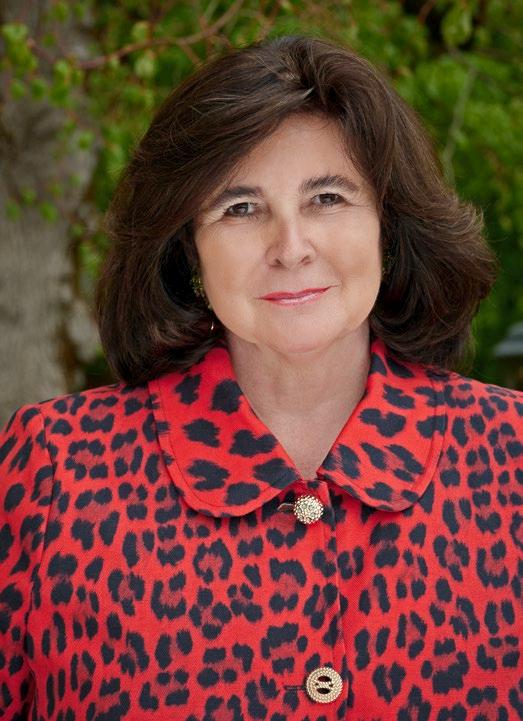
THE Stylemate Issue No 02 | 2022 LH 03 HOTEL DAS TYROL Austria / Vienna
Photo: Jeff Mangione
BOUTIQUEHOTELS.TRAVEL Croatia / Brač / Sutivan Austria / Vienna, Pörtschach, Reichenau an der Rax
( + )
Precious hideaways for individualists. boutiquehotels.travel
Four hotels – four favourite spots. With her four retreats, hotel owner Helena Ramsbacher hasn’t just created four beautiful holiday destinations, she’s also made four very personal lifelong dreams a reality – and her homes. This interview provides some personal insights.
THE SECRET Sölden Curtain up for
It only had its premiere in March but it's already been a huge hit on the big stage. Introducing: The Secret Sölden! Let’s take a tour of the best spots in four acts. THE SECRET SÖLDEN Austria / Tyrol / Sölden Magical and mysterious resort in the middle of the Sölden Alps. the-secret-soelden.com
Overture:
Wonderfully versatile. LA’LIV is the heart of The Secret Sölden, the place everything flows into. As soon as you step foot in the building, you find yourself in the middle of the lounge. It’s all been carefully curated and the atmosphere has been well considered. It’s a location where you can feel fully at home.
The lounge and the neighbouring restaurant both bear the same name. The stylish and modern interior design flows throughout the whole ground floor of the hotel. From the exclusive furniture to the extravagant lighting and the specially made images, you’ll always find something new in LA’LIV.
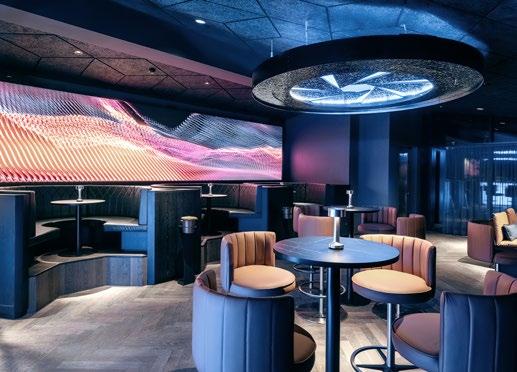

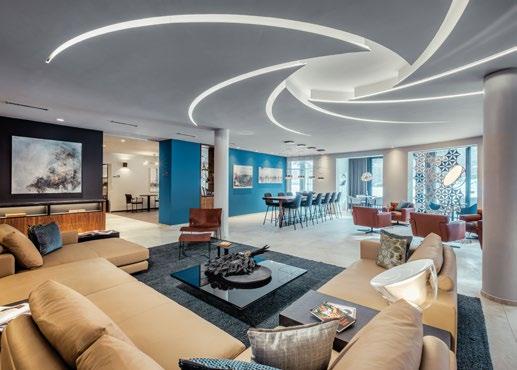
Act one:
SIGNATURE APARTMENTS
These apartments are a refuge for every guest. Here, you can enjoy your holiday in total privacy, if that’s what you wish. Sensual burgundy and natural materials like wood and stone dominate the design of the apartments. The marble-look baths with high-quality designer fittings lend the whole setting a feeling of exclusivity. To ensure flexibility, every apartment has a fully equipped kitchen.
Hymn:
The brand new LE FEEL wellness facility isn’t huge at just 365 m 2 , but over two floors, it offers everything required for a little down time after an active day in the mountains. On the upper floor, there are two saunas (organic and Finnish) with stunning views of the magnificent Sölden mountain landscape. A steam room, experience shower with an ice fountain and two relaxation areas that face the garden round off the upper floor. On the ground floor, there’s a large indoor-outdoor pool with massage jets and the perfect temperature. Taking the plunge inside then surfacing again outside gives the ultimate feeling of freedom.

Grand finale:
On the roof of The Secret Sölden, you’ll find the spectacular THE VUE skybar – the only skybar in the Sölden town centre. With state-of-the-art video and sound installations and its extravagant interior, the special nature of the location also comes across here. There are light installations in the form of a James Bond gun barrel, an illuminated bar made from marble and a fabulous view into the distance or of the starry skies thanks to the partly glazed ceiling. It really is the crowning glory of the Sölden bar scene. It’s where life is celebrated in cosmopolitan and stylish surroundings.
THE Stylemate Issue No 02 | 2022 LH 04
( + ) Photos: Dengler Matthias THE SECRET SÖLDEN Austria / Tyrol / Sölden
LA’LIV
LE FEEL THE VUE SKYBAR
QUESTION DECISIONS
Do I really need to take the car for this journey or can I walk it? Should I buy my meat from a large chain supermarket, where it’s probably been transported for many kilometres by truck, or should I buy it from the butcher round the corner? We all face decisions like these every day – and the best answer is usually to take the environmentally friendly alternative. Although it can be more inconvenient and expensive, it pays off in the long run. The most important thing is not allowing the intentions to be just that – but also putting them into action. We all need to follow through with our environmentally friendly and resource efficient ideas and make them happen. That’s the only way to ensure the necessary and positive transition to greater environmental awareness.
IN HARMONY WITH NATURE
Anyone who’s ever been to the Gradonna****s Mountain Resort will know that it sits above Kals like an amphitheatre. The spectacular natural surroundings and jaw-dropping view are highlights for Martha Schultz, who gets to enjoy them every day. The hotel and 42 chalets were constructed out of wood –a traditional building material in the Alps. Because of this, the resort practically blends into the breathtaking East Tyrolean backdrop and creates a particularly pleasant sense of well-being for guests. Once again, the Gradonna****s Mountain Resort is a pioneer in this area: in future, it will be important to make use of sustainable raw materials for construction, and instead of standing out from nature, perhaps we should look at building and living in harmony with it.
TRAVEL SUSTAINABLY SAVE ENERGY AND WATER
The majority of emissions attributed to the tourism industry are generated by holidaymakers travelling to and from their destination. But luckily, we’ve done something about this over the past few years. For a long time now, the Gradonna****s Mountain Resort has encouraged the arrival of tourists by public transport. Be it by train or by bus, guests can be picked up from any station in Lienz or Matrei-Huben and transported in an environmentally friendly manner to the car-free resort at the foot of the Großglockner in the hotel’s own hybrid vehicles.
RELAX THE NATURAL WAY
05
A bit to the right. A little to the left. But always vegan and free from animal testing. That’s what’s best for the skin, for the environment and for animals. And it’s why the four-star resort has its own range of cosmetics products: MAGDALENA’s made in Tyrol – natural, vegan, refillable and enriched with the freshest Alpine herbs from the Hohe Tauern. Thanks to this combination, guests at the sustainable resort will find deep relaxation with a clear conscience. The Gradonna****s Mountain Resort turns time into happiness.
In this respect also, the Gradonna sets the benchmark: once they’ve arrived at the hotel, guests are able to relax in full harmony with nature. The energy for the heating and hot water is obtained from the hotel’s own wood pellet boiler. The fresh mountain water comes from a spring in the Hohe Tauern mountain range and supplies guests of the lifestyle resort in Kals with pure H 2O every single day.

EAT REGIONAL AND SEASONAL
We all know that you are what you eat. And that it’s best to eat regional and seasonal. The same mindset applies when shopping, and for that, guests at the Gradonna****s Mountain Resort don’t even need to leave the hotel. The hotel’s own shop has everything you could possibly need during your stay – and of course it’s all of the best quality and sourced from regional producers. Head chef Michael Karl also cooks exclusively with ingredients from regional partners, and the game, veal and beef he and his team use come from the hotel’s own butcher. Well, we don’t actually have our own butcher, but we’re able to rely on local suppliers for our meat or can get our steak from the farm right next door. There are plenty of opportunities to eat regionally and seasonally in Austria.
THE Stylemate Issue No 02 | 2022 LH 05 Photo: Gradonna****s Mountain Resort GRADONNA****S MOUNTAIN RESORT Austria / East Tyrol / Kals am Großglockner
04
03 02 01
06
6
day GRADONNA****S MOUNTAIN RESORT Austria / East Tyrol / Kals am Großglockner Natural Alpine paradise of the highest level. gradonna.at ( + )
We
all know the rule: five (portions of fruit and veg) a day to maintain your health! Martha Schultz from the Gradonna****s Mountain Resort swears by her six a day to make sure she does her bit for the environment. But what exactly is involved? Let’s find out!
a
Back to their roots
BERGLAND DESIGN AND WELLNESS HOTEL SÖLDEN Austria / Tyrol / Sölden
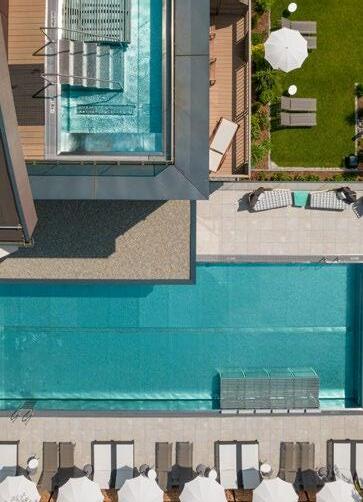
Modern interpretation of traditional design made from regional materials. bergland-soelden.at
Sara is studying tourism and leisure in Innsbruck and is currently in the middle of her course. Learning, learning, learning is the order of the day. Her sister Anna graduated from tourism college last year and before she returns to the family hotel kitchen this summer, she’s currently expertly mixing drinks in an ice bar. But the fact that both of them will end up in the tourism industry wasn’t always the obvious outcome – at least not for Sara. “I actually wanted to be a ski racer. But then I enjoyed the tourism industry so much that I chose this path,” explains Sara about her career choice. Anna knew early on what she wanted to do. As a child, she helped her grandmother in the kitchen and knew there and then that that would be her future profession. The many new faces and nationalities that she encounters every day at the hotel make her work in this industry even more exciting and extremely varied.
KEEPING IT IN THE FAMILY
There are huge benefits to working with family. “My dad does this, my mum does that and Anna does something else.” Everyone has strengths in their own area so it’s easy to distribute the work like that. Anna’s favourite area is the kitchen where she tries out new recipes – as long as it’s not baking. Meanwhile, Sara advises guests at reception: “I enjoy getting the best for our guests. It’s really important to me to find solutions that are perfectly adapted to what they want.” Sara’s way of actively contributing to the guiding principle of the dynamic hotel is through “active relaxed enjoyment”.

So that everything else also runs in an active and relaxed way, the rest of the hotel staff look after the 86 suites, 2,200 m2 spa and of course the hotel’s own culinary offering: the Wine & Dine à la carte restaurant, the black sheep gourmet restaurant and the hotel restaurant. “Some of our employees have been with us for 30 years. They’re simply part of the family.” Sara and Anna grew up with them as if they were uncles and aunts. And just like real uncles and aunts, the long-standing employees of course know about all the mischief Sara and Anna got up to when they were younger. But secrets stay within the family, naturally.
BACK TO THE FUTURE
Handing over the hotel to Anna and Sara is the aim for the future. With Anna’s practical mind and Sara’s analytical thinking and love of numbers, the sisters complement one another perfectly. But they don’t want to think so far ahead and prefer to enjoy the here and now and looking forward to the weekend. Anna will be jumping straight into the new outdoor pool and after a brief detour to the kitchen, she’ll meet Sara on the activity terrace for yoga and meditation. “Active relaxed enjoyment”, you could call it!
THE Stylemate Issue No 02 | 2022 LH 06 Photos: Christoph Schöch Photography GmbH, Bergland Sölden BERGLAND DESIGN AND WELLNESS HOTEL SÖLDEN Austria / Tyrol / Sölden
Sara and Anna grew up at the Hotel Bergland in Sölden and have been an active part of the family business from an early age. For them, it was enriching to grow up in the hotel in the middle of the Ötztal, surrounded by guests. Having completed their education, they’ve now gone back to their roots.
“My dad does this, my mum does that and Anna does something else.”
( + )
Who would have thought that Salzburg and Venice had so much in common? In the areas of art and culture in particular, there are some remarkable parallels. It was Venetian architects Vincenzo Scamozzi and Alessandro Vittoria who had a huge influence on the artists and buildings in Salzburg in around 1600. Today, this Venetian influence is a blue ribbon – quite literally – that runs through not just the city itself, but also one of the most renowned buildings in Mozart’s Salzburg: Hotel Stein.
Blue is much more than just a colour here. It is a dominant stylistic device and its pivotal role in the harmonious interior design is clear for all to see. The link between Hotel Stein and the lagoon city isn’t just artistic, it’s also a matter of business, with Venetian glass manufacturer Barovier & Toso being owned by the same family as the traditional Salzburg hotel. Things that belong together will always end up together.
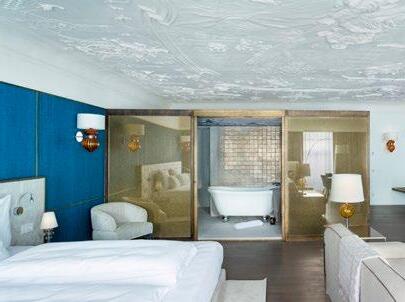
A blue ribbon
Handcrafted masterpieces from the Venetian glassworks –as blue as the lagoon – create a wholly unique design landscape. A glass lighting installation in the stairwell spanning over seven floors leads guests up to the rooms and suites, which are adults-only spaces and as individual as the guests from all over the world that stay in them. The multifaceted, shimmering design object gleams in every possible shade of blue, so it’s worth marvelling at each individual element as if they were in a gallery. But don’t forget they look different all the time depending on the light that hits them.
It’s not just Hotel Stein that has a history worthy of note –Barovier & Toso does, too. It is one of the world’s oldest family-run companies and has made glass works of art for designer names as big as Dior, Dolce & Gabbana and Cartier.

Back to Salzburg
Journey into the blue
In perfect harmony with the glass masterpieces, exquisite fabrics from Venetian fabric manufacturer Rubelli adorn furniture and walls. Be it rich velvet in a warm golden yellow and vibrant turquoise (a colour combination that can be found throughout the whole hotel), blue rugs or mosaic floors – the new lightness of the chosen colour palette and materials pairs perfectly with the historic building. As we mentioned at the beginning: some hotels are much more than a place to sleep. Hotel Stein is most definitely a work of art. A blue one, naturally.
THE Stylemate Issue No 02 | 2022 LH 07 Photos: Edmund Barr HOTEL STEIN Austria / Salzburg / Salzburg City
Some hotels are more than simply a place to spend the night. Hotel Stein in Salzburg is one of them, featuring interior design with historical influences and the most regal of colours, all in keeping with the theme of “Salzburg meets Venice”.
HOTEL STEIN Austria / Salzburg / Salzburg City Salzburg meets Venice. hotelstein.at
( + )
Slow fried
chicken
Separate the chicken into breast fillets, tenderloins, thighs, drumsticks and wings. Remove the skin and the bones from the thighs. Slice the breast fillets in half horizontally.
Marinate all of the chicken pieces in a bowl with the sour cream, parsley, garlic and paprika. Cover the bowl with cling film and leave the meat to marinate in the fridge for at least 20 hours.
For the salad, cook, peel and slice the potatoes. Peel the onions and cut into strips. Peel the garlic clove, crush and mix together with the mustard, stock, vinegar, butter and oil. Season generously to taste and put aside around three tablespoons of this marinade for the lamb’s lettuce. Pour the rest over the potato discs and onion and mix roughly.
Remove the chicken pieces from the marinade and drain. Drizzle with lemon juice and season with salt and pepper. Coat with the flour, dip in the beaten eggs and roll in the bread crumbs.
Fry the chicken pieces until golden brown in two fingers of clarified butter and drain on pieces of kitchen roll. Fry the picked parsley briefly and drain on the kitchen roll as well. Dress the lamb’s lettuce with the marinade put to one side and serve with the potato salad. Add the fried chicken and sprinkle with the fried parsley.
Guten Appetit!
For head chef Dragan Miljkovic and sous-chef Nico Wlodraczak, quality, seasonality and regionality are the top priorities. The restaurant has been awarded one toque from Gault&Millau, and for many years the Gasthof Goldgasse has been listed in the Slow Food Guide. In the dining room of the traditional establishment, you’ll find the original 1719 copy of the Neue Salzburgische Kochbuch (New Salzburg Cookbook), written by the personal chef to the baroque bishop’s court, on display. Conrad Hagger was the name of this chef, and his old recipes are still being reinterpreted to this day. The 700-year-old building is home to a coppersmith that is itself hundreds of years old, so it’s no surprise that some dishes are served out of a copper pan, including one of the hotel’s popular classics – the fried chicken with potato salad.
HOTEL GOLDGASSE Austria / Salzburg / Salzburg City
A homely atmosphere in an artistic gem. hotelgoldgasse.at
GASTHOF GOLDGASSE’S FRIED CHICKEN WITH POTATO SALAD
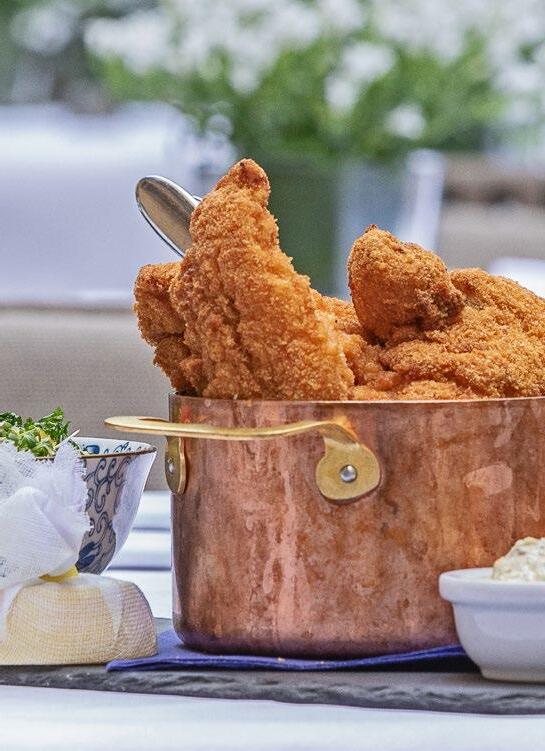
INGREDIENTS TO SERVE 4
CHICKEN:
1 free-range chicken
300 g sour cream
2 tbsp chopped parsley
1 tbsp chopped garlic
Lemon juice (fresh)
A pinch of salt, pepper and paprika
100 g flour
2 eggs (beaten)
150 g bread crumbs
Clarified butter for frying
SALAD:
700 g potatoes (waxy)
2 red onions
1 small garlic clove
1 tsp Dijon mustard
125 ml beef stock (hot)
3 tbsp apple cider vinegar
2 tbsp grape seed oil
2 tbsp brown butter
2 handfuls lamb’s lettuce
1 tbsp fried parsley
THE Stylemate Issue No 02 | 2022 LH 08 Photo: Catalin Cucu
When you’re a guest at Hotel Goldgasse, the Gasthof Goldgasse restaurant is never far away. In the heart of Salzburg’s old town, it’s a beacon of Austrian cuisine, a generous dose of modern spirit and passion-filled reinterpretations.
( + ) HOTEL GOLDGASSE Austria / Salzburg / Salzburg City
PREPARATION
Greetings from the kitchen
Lifestylehotels: The hotel restaurant lives and breathes regional cuisine, with produce direct from the source without long delivery times. How do you come up with new regional dishes to suit the time of year?
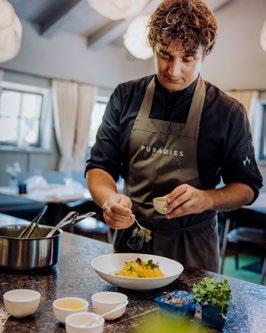
And why is sustainability and regionality so important to the hotel restaurant?

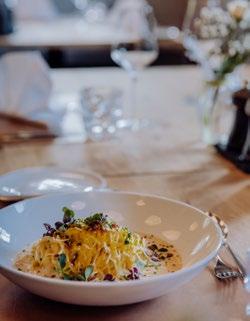
Albert Dschulnigg: Austria is blessed with incredible geological diversity, from the rugged mountains to the smoothed out Pannonian Basin around the Neusiedler Lake. This varied landscape brings with it a particular cornucopia of native fruit and vegetables, flavoursome herbs, fish and meat. That provides variety throughout the season and the creativity emerges all on its own. In winter, we make use of root vegetables, pumpkin and beets, all of which are organic and sourced from the local region. Summer brings lightness and freshness to the menu with wild mushrooms, tomatoes, cucumbers and berries from our forests and gardens. What’s more, we get our selection of meat and fish from local suppliers. We even get our beef and veal from our own organic farm. We have a long history of being sustainable and organic – under its previous name Embachhof, PURADIES was the first farm in Leogang to convert to being organic.
LH: People can see everything when you’re cooking. Do you notice people watching while you conjure up your dishes?
AD: Our guests are able to observe what’s happening in the hotel kitchen through a window looking in, and in our ESS:ENZ gourmet restaurant they can even watch live – front cooking the PURADIES way. Robin Hagen, the head chef of the hotel restaurant, and I really love it when guests show an interest in our work and show passion for cuisine, and we’re happy to let them join in.
LH: What should we consider in future when it comes to cooking regionally and sustainably?
AD: We recommend produce that’s obtained from the local region preferably directly from farmers or a farm shop. That supports not just the business but the community as well, and consumers know exactly where their food has come from. In that way, we’re able to appreciate the hard work and love that was poured into our regional produce.
NATURRESORT PURADIES
Austria / Salzburg / Leogang
Nature resort with design hotel and premium chalets. puradies.com
THE Stylemate Issue No 02 | 2022 LH 09 Photos: Creating Click OG 2022
NATURRESORT PURADIES Austria / Salzburg / Leogang
Gourmet restaurant ESS:ENZ at the Puradies focuses on organic and front cooking. We spoke to head chef Albert Dschulnigg and coaxed out of him some exciting kitchen secrets. Plus a top tip for afters.
ABOUT ALBERT DSCHULNIGG
Albert Dschulnigg is an outdoorsman, free spirit and head chef at ESS:ENZ – which has been awarded two Gault&Millau toques, 91 Fallstaff points, three Fallstaff forks and three-and-a-half wooden spoons from the German Schlemmer Atlas restaurant guide (very good cuisine).
( + )
The Geinberg 5 Private SPA Villas have a lot to offer – most importantly, relaxation. Jacqueline Papke, spa manager at the SPA Resort Therme Geinberg, of which the Private SPA Villas are a part, talks about her work, her favourite places to retreat to, the best treatments and why she makes it a priority to take time out for herself.


Retreat
THE Stylemate Issue No 02 | 2022 LH 10 Photos: OÖTourismus
tbg GEINBERG 5 PRIVATE SPA VILLAS Austria / Upper Austria / Geinberg
Robert Maybach,
Lifestylehotels: Geinberg5 provides plenty of privacy and opportunities to retreat. What’s so special about the Geinberg5 Private SPA Villas?
Jacqueline Papke: The Geinberg5 Private SPA Villas are a place to retreat to with every conceivable luxury. Geinberg5 is part of the SPA Resort Therme Geinberg along with Therme Geinberg, which is also known as the Caribbean of Austria, and yet here you can be totally alone. The villas and suites are nestled in a large garden with direct access to our large, exclusive wellness area. From the jacuzzi and the sauna, you have a breathtaking view of the fabulous hilly landscape of the Innviertel region. And in spring and summer, the terrace, with access to the natural bathing pond, is an absolute highlight.
LH: Is exclusivity a priority for you?

JP: Absolutely! We place great value on things that are special. For that reason, we provide a private butler service to look after our guests at any time of day. Our Oriental World with a hammam is another wonderful and exclusive experience, complete with the navel stone – the heart of any hammam – the CHAI Oriental tea bar, the open arcaded courtyard and a roof garden with a Finnish sauna. I call it a dream from One Thousand and One Nights. Anyone looking for deeper relaxation can pamper themselves in our Vitality SPA.

LH: Which treatment in particular would you recommend to visitors?
JP: Something really special is our exotic massages, such as the Lomi Lomi Nui or the Pantai Luar. Our floating clam is another highlight, where you can experience a feeling of weightlessness and absolute tranquillity. Afterwards, a lovely dinner in our two-toque award-winning restaurant AQARIUM is the perfect way to end a relaxing day.
LH: An added benefit of the Geinberg5 resort is the quick walk directly to the Therme Geinberg. What can be experienced there?
JP: To put it briefly: over 3,000 m² of water, 15 relaxation areas and pools with fresh, salt and thermal water. Our Caribbean lagoon, for example, is especially popular in spring and summer. The widely known Caribbean bar, cocktails served to the poolside, palm trees and a sandy beach ensure an instant holiday vibe. And in the Caribbean sauna area, you’ll find eleven saunas and steam rooms.
LH: Guests are spoilt for choice. Which is your personal favourite place to retreat to at the Therme Geinberg?
JP: I would choose the relaxation garden. It’s centrally located but it’s peaceful and a real oasis, with an exceptional view of the beautiful flowers growing around it. There, you can focus entirely on the moment and fully relax. That’s what a wellness holiday is perfect for.
THE Stylemate Issue No 02 | 2022 LH 11
GEINBERG 5 PRIVATE SPA VILLAS
Austria / Upper Austria / Geinberg
GEINBERG 5 PRIVATE SPA VILLAS Austria / Upper Austria / Geinberg
( + )
A place that touches the heart and the soul and offers every conceivable luxury. geinberg5.com
“
There, you can focus entirely on the moment and fully relax. ”
ABOUT JACQUELINE PAPKE
The trained beautician has already travelled to many places around the world. After having jobs in Turkey, Egypt and on a cruise ship, she has now been in Upper Austria for eight years having found personal and professional happiness.
The glorious
FOR DAMSELS AND PRINCES
Be it a knight’s adventure, legendary fairy tales or the quest to find the ghost in the castle: at the Spruce Tree Castle at Rosenalm, you’re guaranteed a magical time. There’s a climbing tower, a tower chute and even a crane tower for aspiring builders, plus the 18-metre-high viewing tower offers a view of the surrounding mountains. Looking for even more adventure? No problem! You’ll find a BBQ area, treetop path, adventure playground and much, much more.
FOR COOL YOUNG TEENS ONLY – WE MEAN IT!

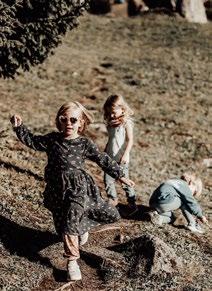
The resort’s Play Factory sounds almost too cool to be true: a bowling alley, pool tables, games machines, table tennis, pinball, Netflix, PlayStations… all of that exclusively for young teens! No annoying parents, no annoying younger siblings. Whether the kids will want to go home at the end of the holiday is anybody’s guess.
FOR POSEIDON AND ARIEL
There aren’t just mountains in the beautiful Zillertal, there are also spectacular bathing lakes. One that’s only a few minutes’ walk away from Mia Alpina is Schlitterer Lake. This gem of a find is especially popular in the height of summer – not just because of the incredibly clear water but also because of the adventure playground in an alluvial forest. Endless fun in the water is also a given at Mia Alpina itself: Woody’s is home to an indoor pool with water slides, an outdoor pool, a family sauna and cosy relaxation rooms.
FOR MOUNTAINEERS AND EXPLORERS
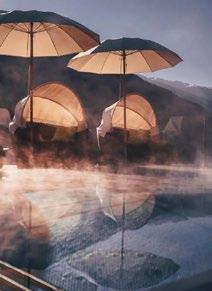
Believe it or not, there are eleven cable cars in Zillertal. One that offers an especially impressive mountain experience is the route up to the Spieljoch ski resort. Just a day in this paradise at around 1,860 metres above sea level is barely enough to take full advantage of the many attractions. To name a few of them, there’s a climbing wall, knaves course, tubing run, crystal village, play lakes, high ropes obstacle course and a show mine just waiting to be discovered.
FOR MUM AND DAD
If anyone’s sitting there thinking that kids find it really stupid when their parents want to spend time in the adults-only PenthouseSPA, let us just clear something up. Kids love having time away from their parents at the Mia Alpina, and parents love having time away from their children on the fifth floor of the family retreat. Be it pleasant laps of the Skypool that’s heated all year round, switching off in the salt steam room, reclaimed wood Finnish sauna or the panoramic relaxation room: the level of tranquillity up here is heavenly.
FOR ANIMAL LOVERS AND BUDDING FARMERS

The animal kingdom has come to Mia Alpina! Alpacas, ponies, goats, rabbits: all of these animals live in the hotel’s very own petting zoo. There are also weekly visits from Wermenerhof, the farm belonging to Alexandra and Martin Kammerlander. During these visits, children learn about agriculture and animals in a playful way.
FOR HIGH-FLYERS AND AERIAL ACROBATS
Want to fly like a bird just once? The Almflieger Gerlosstein can make that happen. With four routes and a length of up to 738 metres, the only way is down. And you’ll even reach speeds of up to 50 km/h. You can take the trip up in the Gerlosstein cable car, then you’ll find the entrance to the Almflieger right next to the mountain station.

THE Stylemate Issue No 02 | 2022 LH 12 Photos: Mia Alpina MIA ALPINA ZILLERTAL FAMILY RETREAT Austria / Tyrol / Fügen Lifestyle for families. mia-alpina.at ( + ) MIA ALPINA ZILLERTAL FAMILY RETREAT Austria / Tyrol / Fügen
7
THE MIA ALPINA FAMILY RETREAT
Are you looking for a hero-worthy activity holiday with the whole family? The Mia Alpina family retreat in Zillertal skilfully combines a stylish atmosphere with family togetherness all under one roof. What will you experience there? You’re about to find out, with our seven holiday tips for activities in and around the resort.
Author: Hannah Stefitz
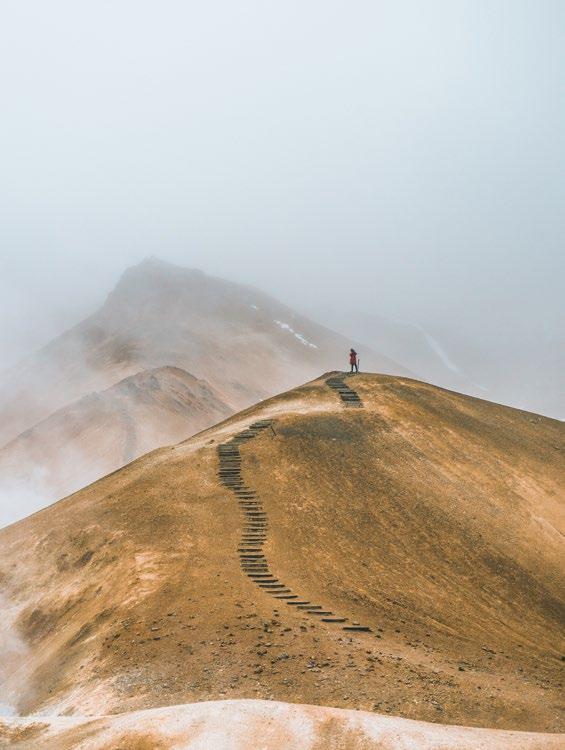
Leni, Alina and Julia all travel solo. To places at the very top of their travel bucket lists and that are now among their very personal places with purpose. What have they gained? New experiences, a great deal of self-awareness and different impressions. All for themselves. What motivates them? High-risk train journeys, meeting lots of new people and sometimes even the fear of not finding a connection.
solo
TRAVELLING SOLO. EXPERIENCING SOLO. ENJOYING TIME SOLO. UNWINDING SOLO.
Photos: Unsplash/Alexander Milo
15 THE Stylemate Issue No 02 | 2022
STYLE
The Italian word “solo”, which translates as “only”, was originally used mainly in the context of music. Now, however, it’s caught on in the travel industry. Three “soloists” tell us what it means to go solo.
LENI
What’s it like travelling on your own?
So exciting! The moment you step onto the plane and you have the whole holiday ahead of you is a really intense feeling. It’s uncertainty paired with anticipation of all of the moments to come. For me, this feeling usually lasts until I’ve reached my accommodation and gained an initial impression. That’s when I tend to get to know the first people, and that quickly dispels any sense of uncertainty. I used to be really scared of not “finding a connection”, but I soon got over that.
So have you never really felt alone?
Not really. When I travel on my own, I usually book accommodation that gives me the opportunity to quickly meet other people. It might be a (surfing) guesthouse, or even accommodation for remote workers. Spain and Portugal in particular are perfect for solo travellers and remote workers – and not just in cities like Lisbon and Barcelona, but also in places like the western Algarve or the Canaries. And for all the remote workers, there are also Slack channels where you don’t just schedule meet-ups and share restaurant recommendations, you can also share accommodation availability. Anyone that doesn’t want to be alone will always find a way to meet other travellers.
Remote working: how do you benefit from working away from home?

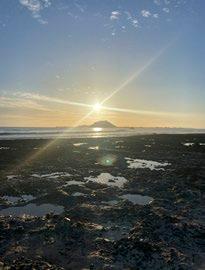
I was and still am a big fan of the portable home office. The pandemic showed that remote working doesn’t mean an end to productivity and that it doesn’t matter where we work from (at least, this applies to me and my own work – there are of course exceptions and I don’t mean to generalise here).
I’ve already been to Mallorca and Fuerteventura this year, and remote working went really well both times. At my agency, all employees are given laptops, and that means we’re already halfway there. What makes a portable home office so attractive to me is the change of scenery and the improved work-life balance.
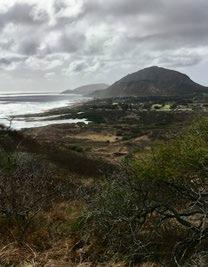

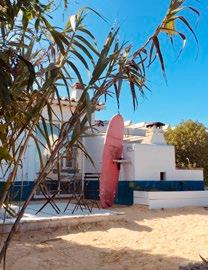
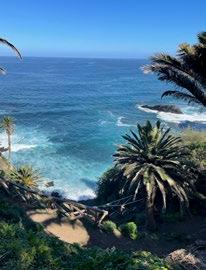
16 THE Stylemate Issue No 02 | 2022 Photos: Leni
STARTING WITH LANGUAGE TRIPS TO MIAMI AND MALAGA, LENI QUICKLY GOT USED TO MAKING SOLO TRIPS. IT’S ESPECIALLY PRACTICAL WHEN FRIENDS DON’T HAVE THE TIME OR ANNUAL LEAVE LEFT TO GO ON HOLIDAY.
ABOUT LENI Marlene Petz is originally from the beautiful city of Salzburg. But for the last several years, her life has centred around the harbour city of Hamburg, the starting point for her international travels! @lenidaisy
ALINA

What do you like about travelling on your own?
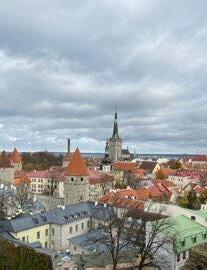

On the one hand, it’s a step out of your comfort zone. You’re not in your usual environment with all the same people and the same everyday routine. On the other hand, though, it’s about flexibility. You can just head off spontaneously on a trip the next day without having to consider any other people. Travelling alone therefore also comprises an element of selfishness – simply because it enables you to do whatever you want.
What’s it like travelling on your own?
Exciting. Travelling alone is really exciting because you never know what’s going to happen or which people you’re going to meet. It’s best not to plan the journey in too much detail and to remain open. That’s when experiences happen that you couldn’t possibly have dreamt of, or you meet people you might never have got to know otherwise.
Do you travel in a different way when you’re on your own?
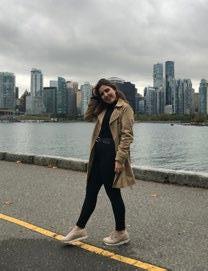

Yes. The biggest freedom of travelling alone is that you don’t have to consider other people. If I’m on my own, I don’t go on a classic tourist’s holiday – instead, I prefer to live each day calmly. I like to go for breakfast first thing, then I take my time looking at everything in peace. That means my everyday routine is rather relaxed, laid back and unplanned –and it’s all the better for it!

17 THE Stylemate Issue No 02 | 2022 STYLE Photos: Alina
ALINA IS AN EXPERT WHEN IT COMES TO SOLO TRAVELLING, HAVING VISITED
18 CITIES – SOME OF WHICH HAVE BEEN CLOSE BY LIKE BERLIN, WHILE OTHERS HAVE BEEN FURTHER AFIELD LIKE MONTREAL, AND SOME RATHER UNREMARKABLE LIKE VILNIUS. BUT EVERY TIME, SHE COMES BACK WITH NEW EXPERIENCES.
ABOUT ALINA Alina Töpfermann is doing her Master’s remotely in Klagenfurt, but has been living in Vienna for a while. When she’s not planning her next trip, she’s planning her next recipe on @theveganaustrian.
JULIA
Did you adapt to the culture of the country?


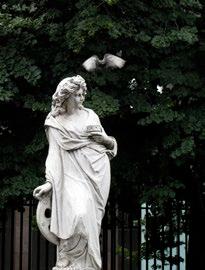

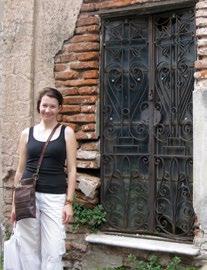
Yes, I would say so. You immerse yourself in everyday Argentinean life, and the longer you live in a foreign city, the more you adapt to the cityscape, the lifestyle and even the attitudes of the people. I noticed it especially with clothing styles because I started wearing skirts more and more frequently. But the focus is mostly on yourself and you have more courage.
Have you always felt safe?
When you think about Argentina, you naturally think about crime and poverty, but I have always felt safe. Perhaps even too safe. After a weekend trip back to the city, I took a late train and didn’t arrive home until late at night – and of course then I walked back to my accommodation. My landlady at the time told me off for how reckless I’d been to do that as a woman, at night, alone. So perhaps I was just lucky.
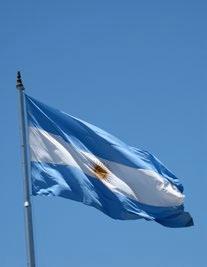
Have you ever felt alone?
In the evenings, yes. When you sit down to eat on your own, sometimes the loneliness can creep in, or just before you go to sleep. But never during the day! You’ve got so many plans and you’re occupied by all of the new sights and adventures that you just don’t have time to feel alone, you’re just enjoying it.
18 THE Stylemate Issue No 02 | 2022 Photos: Julia
QUITE UNEXPECTEDLY, JULIA HAD TO TRAVEL TO ARGENTINA ON HER OWN FOR THREE WEEKS. ORIGINALLY PLANNED AS A COUPLE’S TRIP, THE ADVENTURE TURNED OUT TO BE QUITE DIFFERENT. IN THE END, SHE WENT THERE AS AN AUSTRIAN AND RETURNED AS AN ARGENTINEAN.
ABOUT JULIA Julia Rinesch moved from Munich to Carinthia for love, and stayed there. But her next trip hasn’t been planned as a solo expedition, she’s going with her son – so he can see the world, too.
for 10 tips solo travellers
PURPOSE
AND MINDFUL TRAVELLING – YOU CAN EXPLORE THE WORLD THIS WAY, TOO!
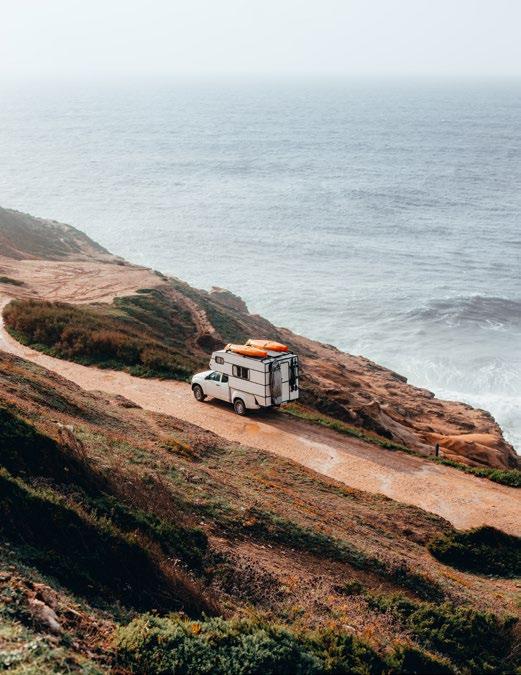
1. IT’S IMPORTANT TO PLAN THE HOLIDAY A LONG TIME IN ADVANCE AND FOR A LONGER STAY.
2. QUESTION HOW YOU’RE TRAVELLING: CAN IT BE DONE BY TRAIN OR BUS, AND IS A FLIGHT REALLY NECESSARY?
3. LITERARY WORKS ARE OFTEN THE BEST TRAVEL GUIDES. FIND OUT ABOUT YOUR DESTINATION IN ADVANCE AND BE LED BY POETS.
4. MENTALLY, THE JOURNEY HAS ALREADY BEGUN. SO ENJOY THE ANTICIPATION AND THE IMAGES THAT COME TO MIND!
5. IF YOU DON’T KNOW THE LANGUAGE SPOKEN IN YOUR DESTINATION, LEARN A FEW WORDS OR PHRASES IN ADVANCE. THAT WAY YOU’LL MAKE A QUICKER CONNECTION AT THE SAME TIME AS SHOWING RESPECT.
6 MEET UP WITH LOCALS WHO KNOW BEST ABOUT WHAT’S GOING ON IN THEIR COUNTRY, AND IN DOING SO YOU’LL GET TO KNOW NEW PEOPLE.
7.
PUT YOUR PHONE AWAY! NOT EVERYTHING NEEDS TO BE PHOTOGRAPHED AND DOCUMENTED TO BE REMEMBERED.
8 .
STAY OPEN TO NEW THINGS AND BE TOLERANT. ALLOW YOURSELF TO DRIFT AND YOU MIGHT EVEN DO SOMETHING YOU’VE NEVER DONE BEFORE.
9.
MAKE THE TIME TO HAVE IN-PERSON CONVERSATIONS WHEN YOU’RE TRAVELLING. YOU CAN HAVE YOUR HEAD IN YOUR PHONE WHEN YOU’RE AT HOME.
10.
DON’T JUST LOOK FOR A HOTEL BASED ON HOW NICE IT LOOKS ON INSTAGRAM. WHAT’S MORE IMPORTANT IS WHAT YOU CAN TAKE BACK HOME WITH YOU AFTER YOUR VISIT!
19 THE Stylemate Issue No 02 | 2022 Photo: Unsplash/ Toms Rits
PLACES, SLOW LIVING
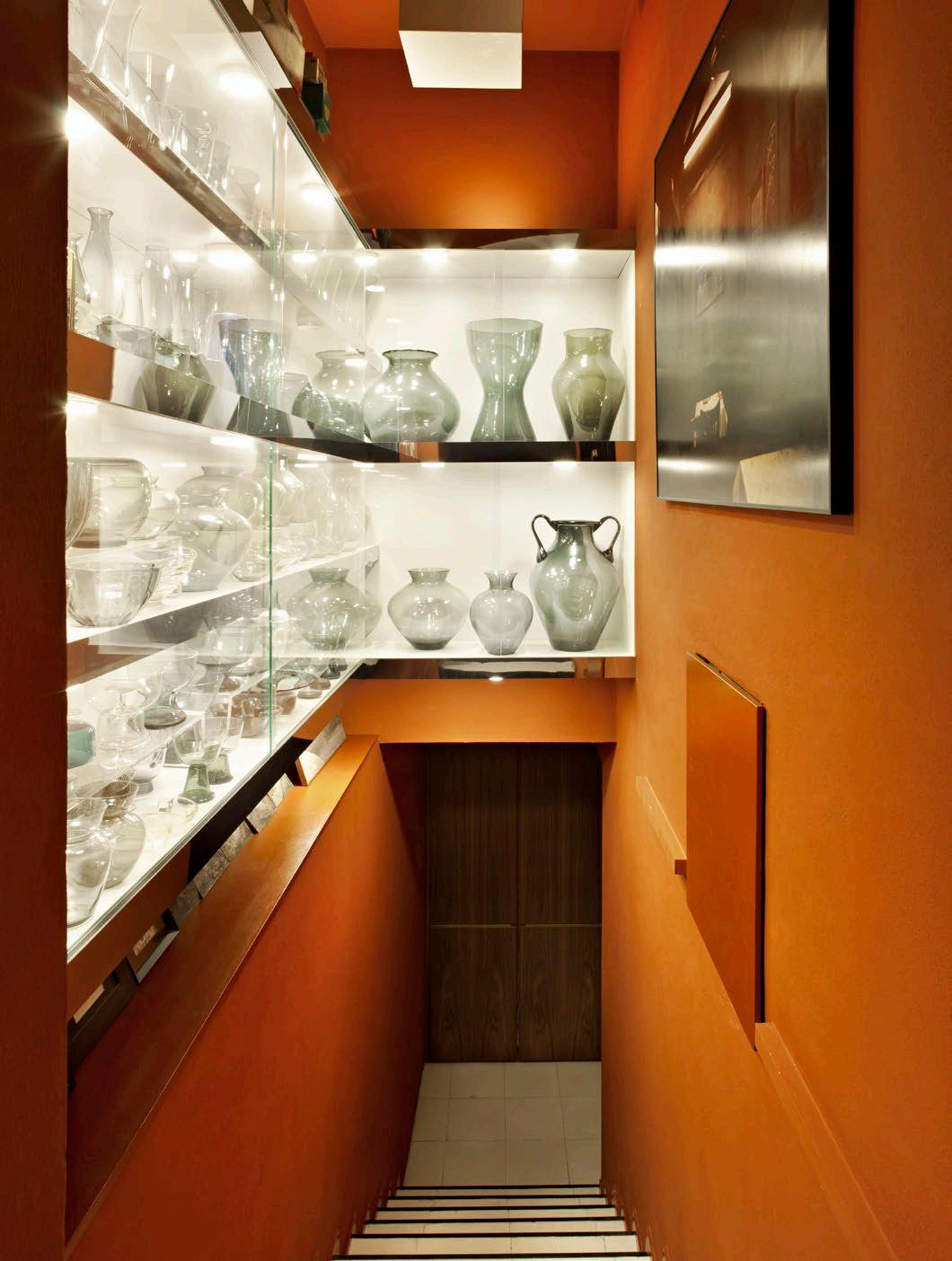
20 THE Stylemate Issue No 02 | 2022 Photo: Santi Caleca
TWO STORYTELLERS BRING TOGETHER ART AND DESIGN TO TELL THEIR OWN STORY.
THIS FORMER GLASS FACTORY IS THE HOME OF TIZIANO VUDAFIERI, FOUNDER AND PARTNER OF THE VUDAFIERI SAVERINO PARTNERS DESIGN AGENCY, AND HIS WIFE CATHERINE VAUTRIN. HERE IN MILAN, THEY’VE CREATED A SPACE THAT’S IN CONSTANT FLUX, WHERE THE
equilibrium
Splashes of colour, movement and light. Situated in the heart of Milan’s Porta Venezia, the private home of Tiziano Vudafieri and his wife Catherine Vautrin is a spacious loft in the internal courtyard of a traditional Milanese residential building dating back to the last century. Through the eclectic selection and clever combination of classic design pieces and contemporary artworks, the couple has turned the abandoned glass factory into part of their own personal story. Architect and fashion manager by day, collectors by night, Vudafieri and Vautrin are continually reshaping the interior of their home thanks to their permanent intellectual curiosity, and have now arrived at the fourth incarnation of their home in 12 years. Their “modern, bourgeois house”, as they call it, is a place where you can live, but also a receptacle in which art is regularly placed to skilfully transform the living spaces. Across three floors, the 340 square metres that surround a patio are bursting at the seams with stories.

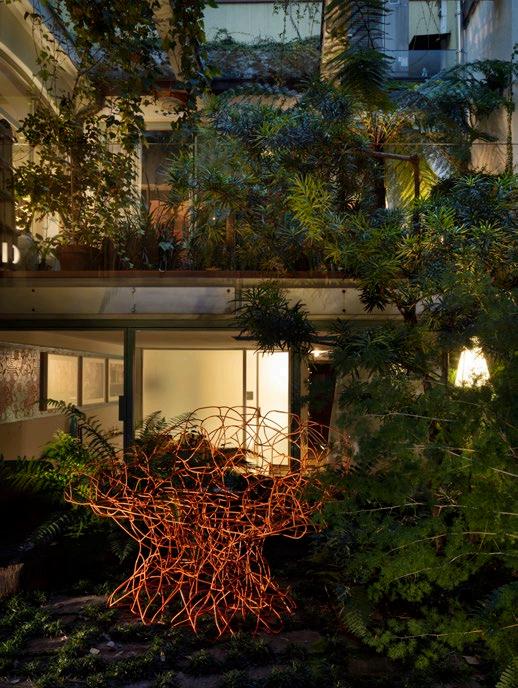
In the revamp before this one, they achieved a radical change in the functional separation of the living and dining areas through the addition of a gigantic bronze of the Eiffel Tower by Aldo Mondino. Two years before that, the house was handed over to artist Gabriele de Santis, who spent six months totally transforming the building on the basis of the Case Chiuse artistic initiative. For many years, it’s this dialogue with art that’s become a key aspect of Vudafieri Saverino Partners’ design language. Founded in 2000 by Tiziano Vudafieri and Claudio Saverino, the architectural firm with offices in Milan and Shanghai has enjoyed collaborations with fashion labels
such as Delvaux, Pucci, Tod’s, Louis Vuitton, Kenzo, Roger Vivier, Moschino and Sonia Rykiel. The firm has also successfully redefined the functional and aesthetic norms of the restaurant trade in collaboration with award-winning chefs including Alessandro Negrini and Fabio Pisani, Pierre Gagnaire, Hervé Bourdon, Enrico Bartolini and Andrea Berton. Thanks to these partnerships, they’ve created numerous innovative restaurant concepts in Milan and around the world.
ICONIC OBJECTS
The loft is a contemporary space that embodies the very personal vision of the architect and his wife. The couple’s home shares their passion for art and collecting, and has become a portfolio of artworks and iconic vintage pieces they have come across and collected then displayed alongside custom design pieces by Vudafieri. The home plays on the relationship between upper and lower levels: the inner courtyard acts as a centre point and light shaft, while the stairs, paths and corridors create the impression of movement. That makes the layout a surprise, saturated with lovely transitions and unexpected spaces. “The result is a series of different places where you can spend time,” explains Vudafieri. The open, interconnected spaces are in constant communication with one other, with the living and dining areas merging seamlessly. Through the addition of large glass areas (which create a link with those of the former glass factory), the idea of a visual bridge could be brought to life.
21 THE Stylemate Issue No 02 | 2022 Photos: Santi Caleca Eclectic
The interior spaces have been made higher through the use of transparent materials and natural light, and are elegantly paired with original features such as the Catalan arch, which delicately defines the ceiling.

vudafierisaverino.it
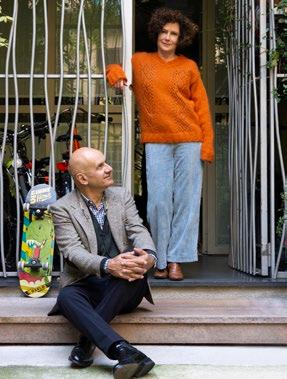
22 THE Stylemate Issue No 02 | 2022 Photos: Santi Caleca
MONOCHROME SURFACES
Over the years, the interior spaces have undergone a series of alterations and changes to wall colours, as well as varying configurations of artworks and furniture. During the most recent transformation, the colour scheme was changed entirely. It was the designs of Le Corbusier’s monochrome wallcoverings for Salubra from the 1930s and 1950s, with their unconventional colour palettes that were outside the norm for modern décor, that gave Tiziano Vudafieri the idea of transforming several walls into large monochrome surfaces. That’s how blue and red walls have come to dominate the large central area, and the single-colour theme continues in the lime green entrance hall, the grey-blue kitchen and the green in the master bedroom. “These colours are taken from neoclassical London interiors to further underline the eclectic mood,” say the inhabitants.
The artwork is subject to ongoing change and arranged in accordance with Vudafieri’s concept of the “eclectic equilibrium”. In the living and dining area, the blue surface acts as a backdrop to an abstract canvas by Swiss artist John Armleder, harmoniously positioned next to a large rose by emerging Polish artist Marzena Nowak and a plaster frieze by renowned artist Paolo Icaro. The deep red wall is the display for a drawing, a collage and an oil painting by Nick Devereux, while close by there is a new installation by Victor Man and portraits by Catherine Vautrin’s ancestors. The same principle can be found in the design pieces.
Alongside Aldo Mondino’s bronze sculpture Gerusalemme sit iconic creations by Luigi Caccia Dominioni: velvety black Santambrogio sofas, the LT10 and Porcino floor lamps and two extremely rare glass vases manufactured by Azucena in the 1950s and 1960s. The marble and the wood tables between the sofas are by Ettore Sottsass for Ultima Edizione.
They’re complemented by Sasso lamps by André Cazenave for Atelier A, Marteen Baas’ Clay Furniture Bank for Rossana Orlandi and Le Corbusier’s Lampe de Marseille grey wall lights produced by Nemo Lighting. In the centre of the dining area, there is a custom-made Vudafieri Tratto table paired with Danish teak chairs from the 1960s and a glass sculpture by Droog Design. On the table stands a rechargeable Tetatet lamp by Davide Groppi.
GREEN OASIS
The patio in the centre of the building is a green oasis and the focal point of the project. Designed by Vudafieri with architect Lorenzo Bini and brought to life by garden designer Alessandro Nasti, this secluded garden combines plants, wood and stone with design features such as the 1960s Danish fibreglass Flötotto chairs and the Corallo armchairs designed by the Campana brothers and produced by Edra. The oasis can be seen from all of the rooms through windows and terraces, and can also be accessed from the living and sleeping areas, making it feel like an extra room outside.
SOCIAL LABORATORY
With glazed doors leading to the dining area and to the outdoor terrace, the kitchen is flooded with light and serves as a laboratory for the architect and a room where he can indulge his passion for cooking. Vudafieri places great value on the kitchen as a working and social space, and this inclination can be seen in the homely surroundings that have been created, whose design works well to provide a functional space for family and friends. The central wooden table was made by Fratelli Bianchi out of Lebanese cedar. The artisans from Cantù are also behind the bespoke manufacture of the interior furniture, internal doors and the kitchen. The table is partnered with Othmar Barth Sella chairs from 1962 and a glass dome chandelier with a brass frame, a prototype by Federico Peri made by Nilufar. The room is delicate and light, just like the blue-grey colour on the wall as chosen by Le Corbusier.
TIMELESS MASTER BEDROOM
The master bedroom is bathed in dimmed light, a cocooning room with green walls and a ceiling that reflects a sense of timelessness and the green of the terrace and outdoor patio, which can be accessed via the large floor-to-ceiling windows. Contrasting with the brick red floor, the green wall in the room draws attention to a sequence of photos by Linda Fregni Nagler under the title Mourning, Massimo Bartolini’s photo Im Gespräch mit Lisa and Umberto Riva’s

Robot lamp for FontanaArte, a Murano pendant lamp from the early 20th century and a large table lamp from the 1960s – all of which express a hint of the eclectic and tell stories of the past and the present.
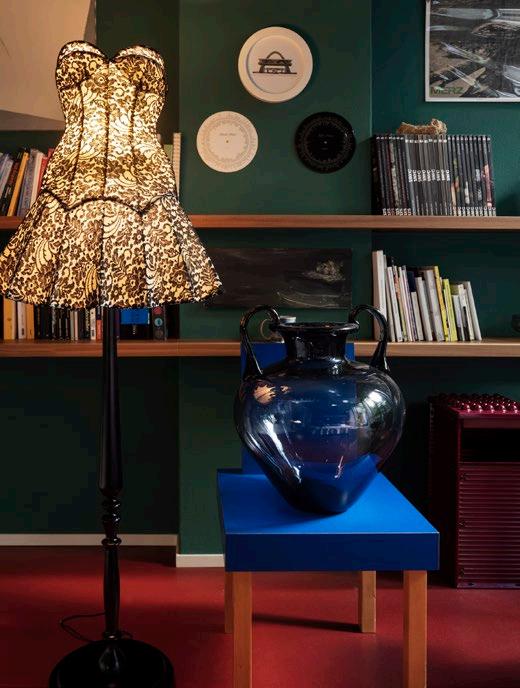
PERFECT TRANSITIONS
The staircases and corridors are treated as spaces in their own right and not just as intermediate spaces. The stairs are bathed in vivid orange, which links the main area with the other spaces. In one of the two guest bedrooms, there is an impressive collection of vases by Wilhelm Wagenfeld, a designer and teacher of the Bauhaus art school who wasn’t very well known in Italy but had major exhibitions at locations such as MoMa. The stairs have a transparent balustrade that leads up to the other guest bedroom, which functions as a gallery space for a range of oil paintings by French artist Vincent Ruffin.
All in all, Tiziano Vudafieri and Catherine Vautrin’s home is an eclectic oasis that tells a personal story between the past and the present, modernism and a very emotional lifestyle.
23 THE Stylemate Issue No 02 | 2022 STYLE Photos: Santi Caleca
KANSHITSU IS THE NAME GIVEN TO A TRADITIONAL JAPANESE LACQUER TECHNIQUE. HANDBAG BRAND SAGAN VIENNA HAS NOW USED IT TO MANUFACTURE PIECES INSPIRED BY THE SHAPE AND FUNCTION OF INRO, A TRADITIONAL JAPANESE CASE.
 Author: Nina Prehofer
Author: Nina Prehofer
Kanshitsu
The story of how the Kanshitsu bag came about is one of traditional craftsmanship and innovative construction. One that passionately tells of the craft and how you can redesign production processes using modern technology. To find out more about the development process behind the Kanshitsu bag, Taro Ohmae, co-founder of SAGAN, takes us on a journey to Japan, where each of the ancient Japanese cases was produced to hold medicines and small objects, suspended from an obi belt tied around a kimono.
URUSHI – THE SPECIAL LACQUER
“I learned that urushi was the name of a special lacquer passed down from China to Japan in ancient times. I was intrigued,” says Taro Ohmae.
A great number of Buddhist statues were made during the Nara period using this lacquer, whereby a cloth soaked in the lacquer was applied to a Buddha mould then dried. Afterwards, the mould was removed from inside to complete the statue. The technique quickly spread because the wooden architecture that prevailed in Japan presented a huge fire risk, which put the Buddha statues in danger. But when they were made using the dried lacquer, they were extremely light and could be quickly taken out of a burning temple because they were hollow.
“When I went to visit my family in Japan last year, I didn’t know much about the urushi technique. On a family trip to Hokuriku, I got to know Kohei Kirimoto from Wajima, an old-school lacquer artist, who was kind enough to explain everything to me, to introduce me to the
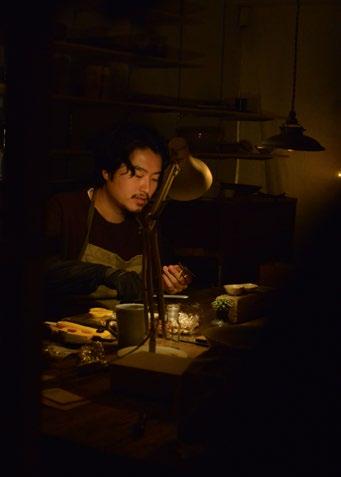
craft and to answer my questions, all of which sparked my interest even more.”
DAKKATSU – THE SPECIAL PROCESS
Just like the Buddha statues, kanshitsu also requires a type of mould during production. This version of the process is called dakkatsu. The mould is made out of a specific clay and plaster and is extremely fragile, meaning it often breaks during the process. For this reason, many pieces are one-offs and reproductions are difficult, time-consuming and expensive. The ancient craft involves the streamlined distribution of tasks, with the completion of one stage of the process having an impact on all of the stages that follow. With all of this in mind, Taro Ohmae and Tanja Bradaric considered how they
could make the moulds using a 3D printer, and together with friend and architect Thomas Milly from the University of Applied Sciences Vienna, they designed the moulds for the bags. Using a 3D printer, it’s possible to reproduce a damaged mould in a very short time, and the same mould can now be used repeatedly in order to save time and money. By incorporating new technology into the production process, the traditional trade can now be viewed from an entirely different perspective.
Tha Kanshitsu bags in S, M and L are made out of 70 % urushi, 10 % rice, 10 % cotton and 10 % kieselguhr.
sagan-vienna.com
Photos: Ayaka Yamamoto
24 THE Stylemate Issue No 02 | 2022
The scent
Perfume has always been the younger sister of time. It wasn’t coincidence that Marcel Proust selected a seemingly random olfactory event as the starting point for his novel In Search of Lost Time, a 4,000-page epic that navigates the irreversibility of time and the reconstruction of the past in our memories. Proust describes how the narrator dips a madeleine into lime blossom tea and the smell and taste involuntarily unlock a memory of his childhood.
What I meant: We owe one of the most significant novels in world literature to a sensory anchor point, the so-called Proust effect. What’s meant by this is the inseparable trio of fragrance, memory and time, inseparable because of the close link between our sense of smell and the limbic system, which is where our memory is located.
But this isn’t the only connection between scents and time: their ephemeral nature,
of the time
makes the whole thing so complex, it’s as if all four movements of a symphony are being played not one after the other, but over the top of each other.
That explains why perfume is slow rather than fast. Only when I’ve heard the end of the symphony of scents, seen the final act at the fragrance theatre, do I really know a perfume. And that takes time. Anyone that’s too impatient risks experiencing the disappointment of a poor purchase following a quick fragrance test in the perfume shop.
Countless perfume names play on the concept of time.
For example, iconic brand Byredo asks for a Slow Dance, causing the dizzy feeling of a Slow Dive (Hiram Green) leading to Slow Explosions (Imaginary Authors) that finally give way to a smouldering Slow Fire (One Seed).

With the simple title of Time, Badafee hones right in on the matter. Krizia, on the other hand, differentiates between Time Man and Time Woman, thereby expressing the time pressure of the gender issue – a conflict that will only be solved by the end of time: Time Stood Still (Nimere Perfumes).
But because time will never actually stand still, moments escape us, and fashion label Salle Privée stands with Proust: Le Temps Perdu. With surrealist subtlety, Salvador Dalí uses Fluidité Du Temps Imaginaire to refer to the fact that the human concept of time, in the proper meaning of the word, is based on a misunderstanding of physics.
their unavoidable evaporation into nothing, is what makes perfumes a symbol of transience. In this way, they are similar to works of performing arts, which, unlike paintings or sculptures, only last for the duration of an evening at the theatre or a concert. Similar to literature, the composition of a perfume is only understood through perception, so it is continually being recreated – after all, scent particles without the nose of the smeller are merely chemical components wafting around.
Like a stage production or a blockbuster movie, a perfume also follows a dramatic composition: first we sense the top notes from the more fleeting, perhaps citrusy and ozonic molecules. The heart notes follow with floral, herbal and spicy notes. As a foundation, balmy, animalic and earthy ingredients come to the fore. The fact that all ingredients remain present throughout the entire performance, alternating emphasis and undergoing changing relationships with one another,
You quickly become a Time Hunter (Christian Brinck), frantically chasing the past, Chasing Memories (Broken Anatomy Perfumes). The Mith label invites us into the Garden of Memory and down Memory Lane (Cristèle Jaquemin) "to catch fragments of the past:" Memories Chasing Butterflies (Oriflame).
It wouldn’t be necessary for a Time Traveller (Sapientiae Niche) to grieve a Sacred Memory (Kerosine) they left behind, they could just visit the past themselves, although it wouldn’t make for a work of literature as produced by the likes of Marcel Proust.
As Buddhists know, the past and the future are just an illusion anyway, and every moment is already the Future’s Past (House of Matriarch) as soon as we’ve experienced it. What remains, therefore, is to live in the moment, to capture the Zeitgeist (F.J. Schwarzlose Berlin), known in French as L’Air Du Temps (Nina Ricci) and in Italian as Essenza del Tempo (Trussardi). Only those who are in control of the moment can turn a Moment Volée (Fragonard) into Momentum Intense (Bentley) or even a Moment Perpetuel, as promised by Les Eaux Primordiales, who work with synthetic molecules.
The never-ending pursuit of happy moments in the present guarantees a happy Tomorrow (Avon), although Tomorrow No 68 by Tokyo Milk Parfumerie Curiosite implies that there could be more than one future. But we’ll never know whether the other 67 tomorrows might have been more exciting…
HELDER SUFFENPLAN is an independent journalist and creative consultant from Berlin, and has had a particular passion for perfumes since he was a child. With his successful 2013 launch of SCENTURY.com – the very first online mag azine for perfume storytelling –Helder has become a recognised authority in the global world of fragrance. He has been on the jury for events such as The Arts & Olfaction Awards in Los Angeles and the Prix International du Parfumeur Créateur in Paris. As a writer, he combines his passion topic of fragrances with a range of fields such as contemporary art, popular culture, literature, film and geopolitics.

scentury.com 25 THE Stylemate Issue No 02 | 2022 Photos: Moment Perpetuel / Portrait: Holger Homann
Green
THIS WAS THE FOCUS OF DESIGN MONTH GRAZ THIS YEAR IN THE UNESCO CITY OF DESIGN GRAZ, HOSTED BY CREATIVE INDUSTRIES STYRIA (CIS). WE HAD A LOOK AROUND AND PICKED OUT TWO DESIGN HIGHLIGHTS.
GOOD IDEAS TAKE TIME
Seven components fit together to make the recyclable TOMB side table: six identical natural stone slabs and a round glass plate that allows you to see through to the stone underneath. Assembly doesn’t require any tools – simply slot them all together and you’ve got a minimalist piece of furniture for life. Its sustainability credentials are also applaudable, as explained by the design duo: “Longevity is always the main focus of our designs. All components are regional and come from companies in the local area, and should be easy to repair, free from any problematic substances and able to be separated into individual pieces.”
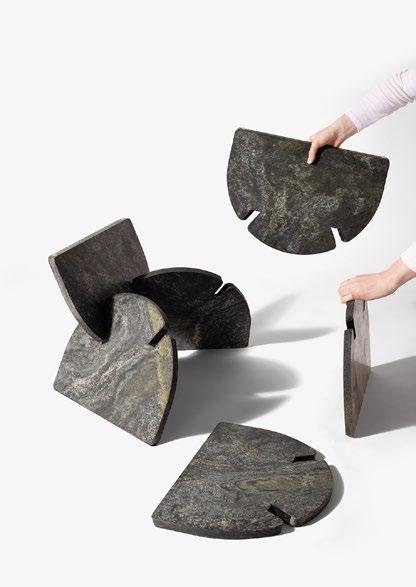

DESIGNER: ANTE UP
In addition to sustainability, what is of particular importance to you during the design process?
With every new design, we firstly put ourselves in the shoes of users and discuss their needs and requirements in design thinking workshops. The concepts we develop in this way are sent straight to testing and we receive instant feedback on the functionality and added value of the designs. The goal is to find that special feature that makes the design stand out and conveys our idea in a playful way.
Do you prefer taking things slow or do you need time pressure and a deadline to achieve a good result?
Our best ideas often aren’t our first ones. We’re only really happy with designs after extensive research and several rounds of improvements – and that simply takes time. Of course, sometimes it’s not a bad thing to have a deadline. But it has to be realistic.
What is your current favourite design object?
At the moment, we can’t get enough of our OPPONENT stool. It’s made from solid oak and is designed in such a way that no material is wasted during production –every piece of wood is utilised. The stool is made in a joiner’s shop in Vienna that enables refugees to enter the Austrian job market, allowing environmental and social sustainability to join forces.
CREATIVE INDUSTRIES STYRIA
Flex and TOMB were displayed in two shops in Graz as part of Design in the City, a format developed for the Creative Industries Styria Design Month Graz. As one of the Styrian products on show, Flex is also an ambassador for good design, smart strategies and clever solutions in the context of design. It tells a story of success, and in doing so reflects the potential of the whole region of Styria and its creative talents. With formats like this, CIS succeeds in continually raising awareness of good design and the associated added economic value.
Wild 26 THE Stylemate Issue No 02 | 2022
Author: Lisbeth
Photos: ante up
ANTE UP was founded in 2020 by Benedikt Stonawski and Hauke Unterburg, who studied at the Design Academy Eindhoven in Holland and the Karlsruhe University of Arts and Design in Germany. Their studio in Vienna is a certified OekoBusiness Wien company and a member of the designaustria Sustainability Experts Cluster, and specialises in circular product and furniture design.
TOMB Side table
Flex is an example of the clever interaction of aesthetics, functionality and innovation, or as the designer himself puts it: “What’s special is the harmonious interplay between the various components within the one design, which still remains very minimal. Flex can be experienced both visually and by touch, making it a truly extraordinary product.” The idea behind the outdoor table is the possibility to create different versions of one product in terms of size, colour and material. The aim was to design a profile that combines with the table legs to form the load-bearing structure and allows the attachment of various other elements. This means a table top made out of Corian, wood or concrete can be mounted on legs made out of wood or aluminium.
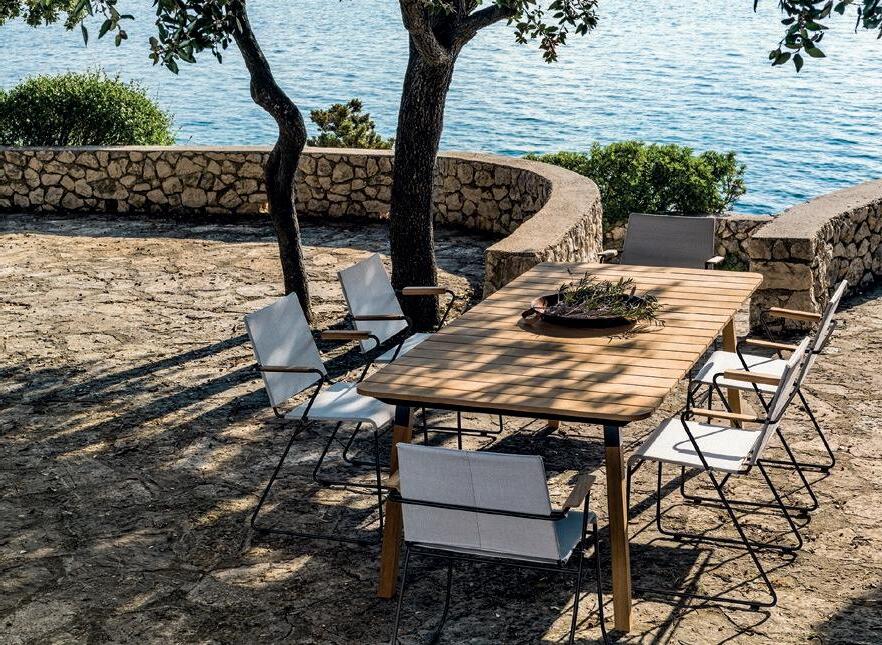
UNBIASED AND FILLED WITH FASCINATION
Where do you get the inspiration for your designs?
I’m inspired by my expertise and by detaching myself from this expertise. I approach every new product with the eyes of a child, unbiased and filled with fascination
How important is slowing down in your everyday life?
Slowing down starts every day with my morning routine: a cold shower and yoga breathing. Because of that, I manage to remain calm throughout the entire day and consider my work from a distance.
What is your current favourite design object?
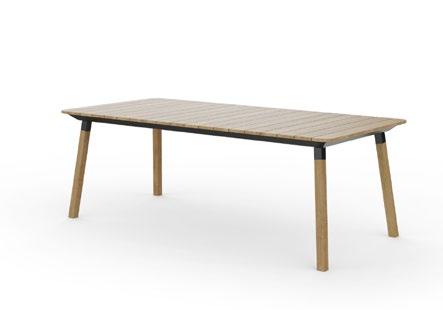
My noise cancelling headphones. I like being able to block out the world for a short time so I can relax.
FLORIAN BLAMBERGER Industrial and product designer Florian Blamberger has a Master’s degree in Art and Design and works mostly in the areas of lighting, furniture and mobility design. He works as both a freelance designer in Graz and Art Director at Johannes Scherr Design. As a lecturer, he teaches at FH Joanneum University of Applied Sciences and the Carinthia University of Applied Sciences in Villach.
27 THE Stylemate Issue No 02 | 2022 STYLE Photos: Croce & Wir,
cis.at
Florian Blamberger
FLORIAN BLAMBERGER
DESIGNER:
Transition
FLEX Outdoor table
Exuding 1950s charm like no other. We‘re not talking about style icon Audrey Hepburn, but about our eponymous luminaire. It should never miss a cocktail party. Why invite it? Because it can change its look more often than any movie star. It looks just as fantastic in matte black as it does in shimmering gold. How does that work? Choose a mounting and combine it with up to eight different shade forms. Looking for an eye-catcher for the wall? You can customise ODREY’s shape with three elegant cuff shapes.
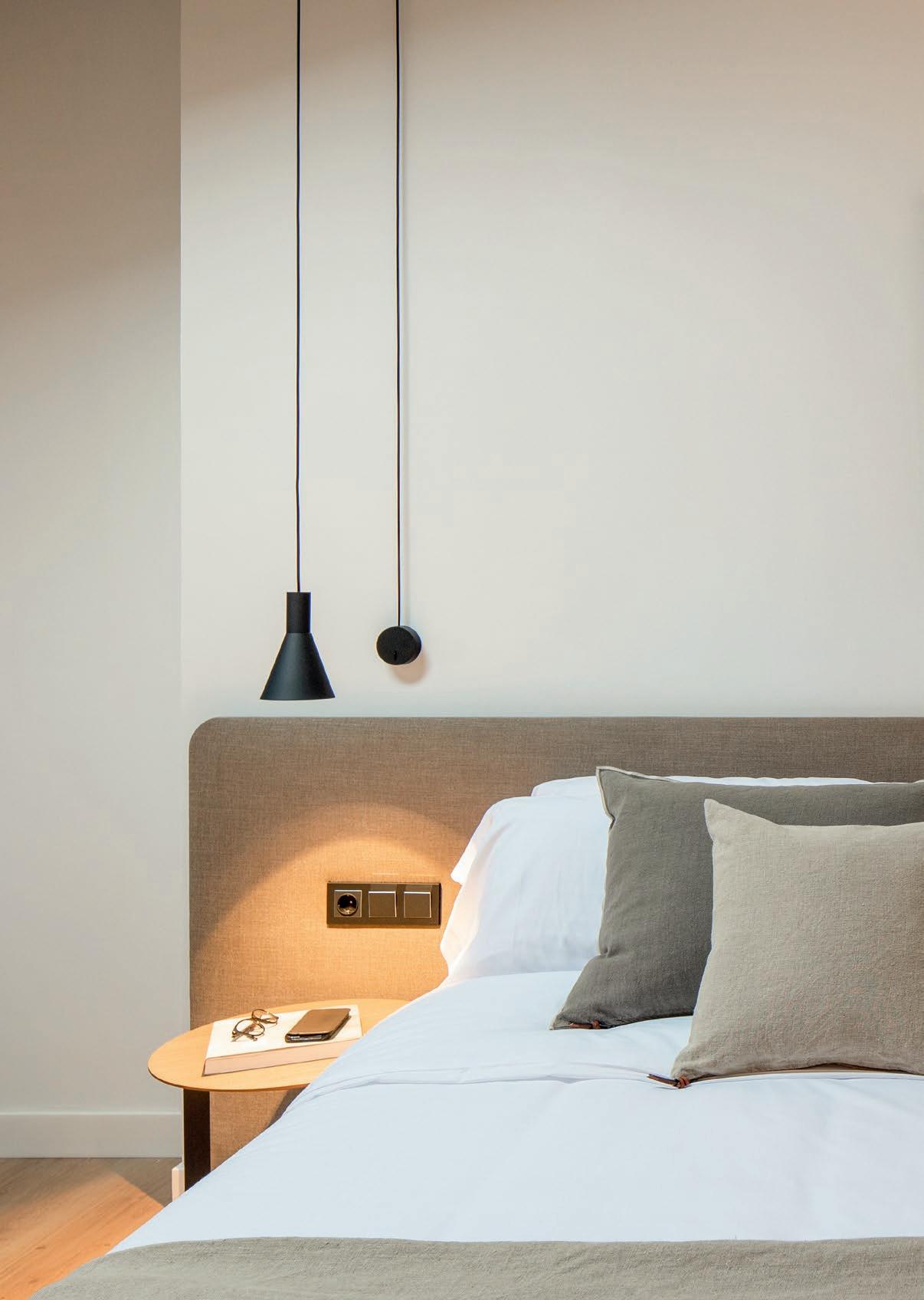
WEVERDUCRE.COM








































































 Author: Nina Prehofer
Author: Nina Prehofer







